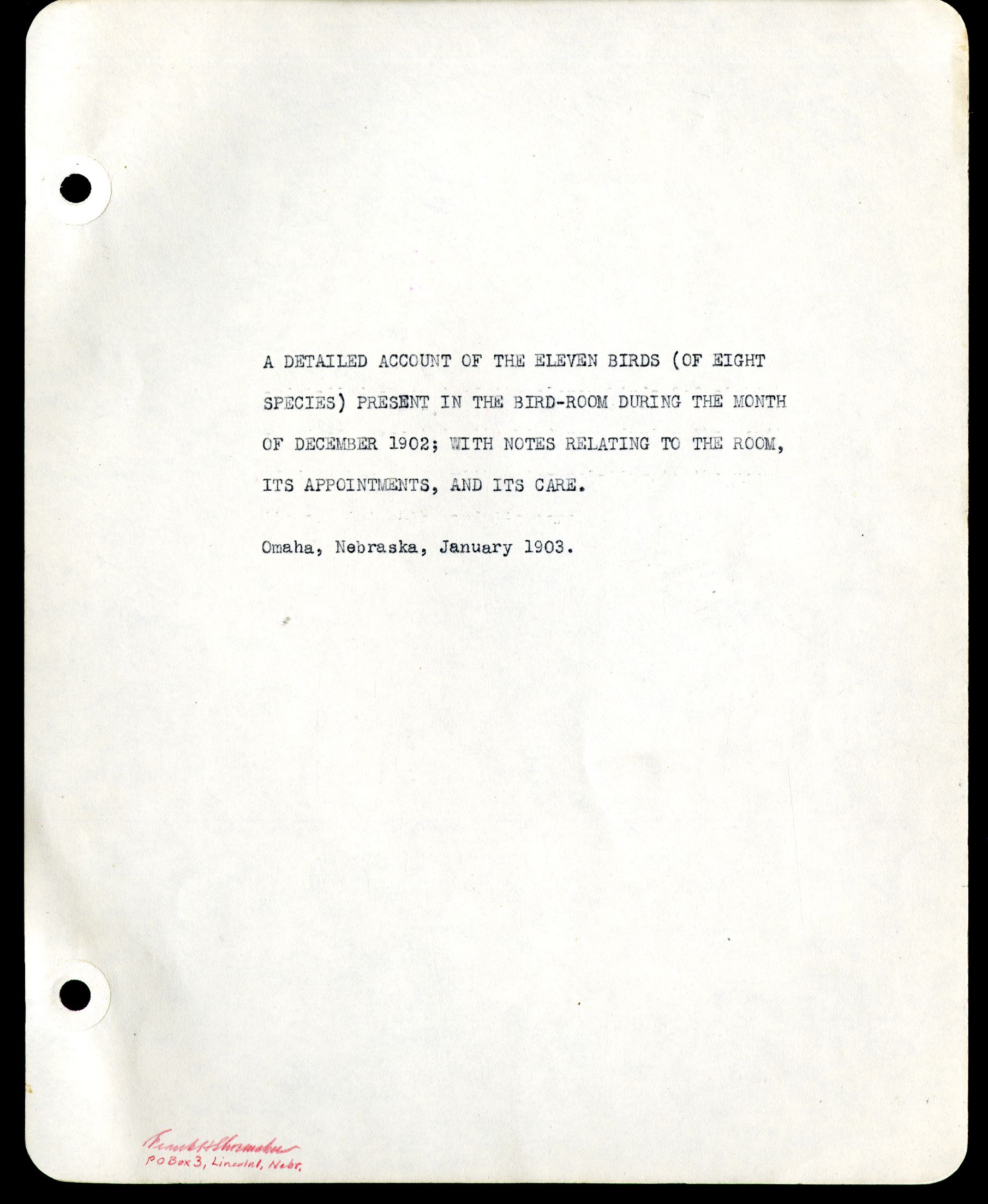Great Nebraska
Naturalists and Scientists The “bird-room” in the Omaha residence of A.C. Van Sant and his daughter Elizabeth – at 2960 Dewey Avenue – was a domestic appendage so unusual, that it interested scientifically the local folk given to bird-study, and interested casually any passing guest.
The “bird-room” in the Omaha residence of A.C. Van Sant and his daughter Elizabeth – at 2960 Dewey Avenue – was a domestic appendage so unusual, that it interested scientifically the local folk given to bird-study, and interested casually any passing guest.
I was a member of the household, and my notes in relation to the bird-room and its varying population, over the period of eight years through which it was maintained, cover hundreds of pages. It was my practice to record memoranda as incidents occurred from day to day, and at the end of each month to summarize these in such detail as seemed desirable. These notes are much too copious and of necessity too repetitive for full reproduction; so in the following account I have described the room and its care in some detail, and have taken the summary for a single month (December 1902), in a period of average bird-population, as representative.
I have extended the scope of this account to include many observations not given in that particular month’s summary, but covered in earlier or later notes. However, such observations relate solely to the individual birds which inhabited the room during the month chosen, and are not notes compiled from observations earlier or later concerning other birds of the same species.
[signature] Frank Shoemaker Jan 10, 1908
[longhand, to replace the section crossed out] the status of the bird-room and its inhabitants from [illegible] month (Dec. 1902) – [illegible] month of average bird population. Following which is detailed information with respect concerning the [illegible] and the [illegible] of the room. The reaction followed the [illegible] and other [illegible]
Sep 19
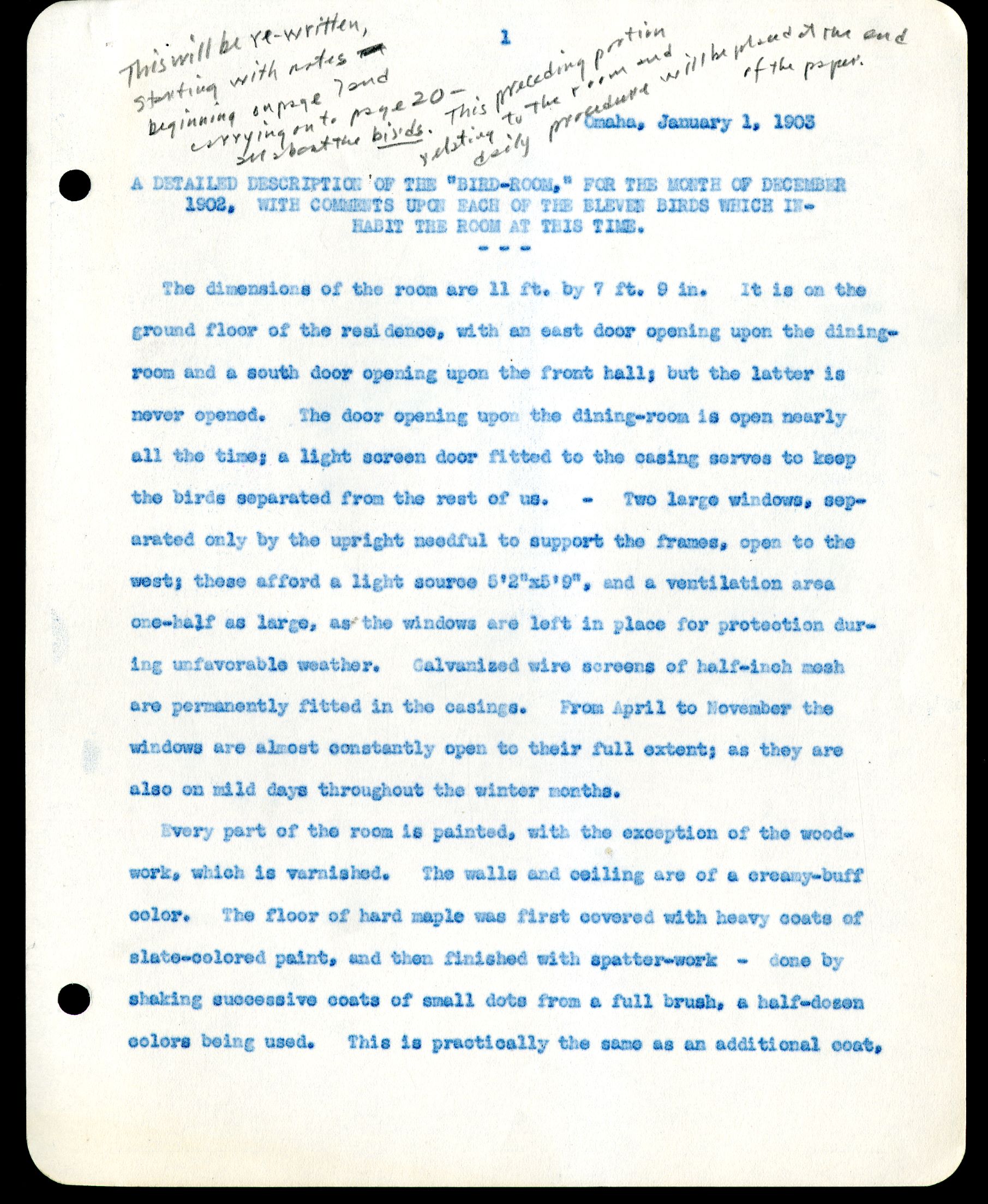
Omaha, January 1, 1903
A DETAILED DESCRIPTION OF THE “BIRD-ROOM,” FOR THE MONTH OF DECEMBER 1902, WITH COMMENTS UPON EACH OF THE ELEVEN BIRDS WHICH INHABIT THE ROOM AT THIS TIME
—
The dimensions of the room are 11 ft. by 7 ft. 9 in. It is on the ground floor of the residence, with an east door opening upon the dining-room and a south door opening upon the front hall; but the latter is never opened. The door opening upon the dining-room is open nearly all the time; a light screen door fitted to the casing serves to keep the birds separated from the rest of us. – Two large windows, separated only by the upright needful to support the frames, open to the west; these afford a light source 5’2”x5’9”, and a ventilation area one-half as large, as the windows are left in place for protection during unfavorable weather. Galvanized wire screens of half-inch mesh are permanently fitted in the casings. From April to November the windows are almost constantly open to their full extent; as they are also on mild days throughout the winter months.
Every part of the room is painted, with the exception of the woodwork, which is varnished. The walls and ceiling are of a creamy-buff color. The floor of hard maple was first covered with heavy coats of slate-colored paint, and then finished with spatter-work – done by shaking successive coats of small dots from a full brush, a half-dozen colors being used. This is practically the same as an additional coat,
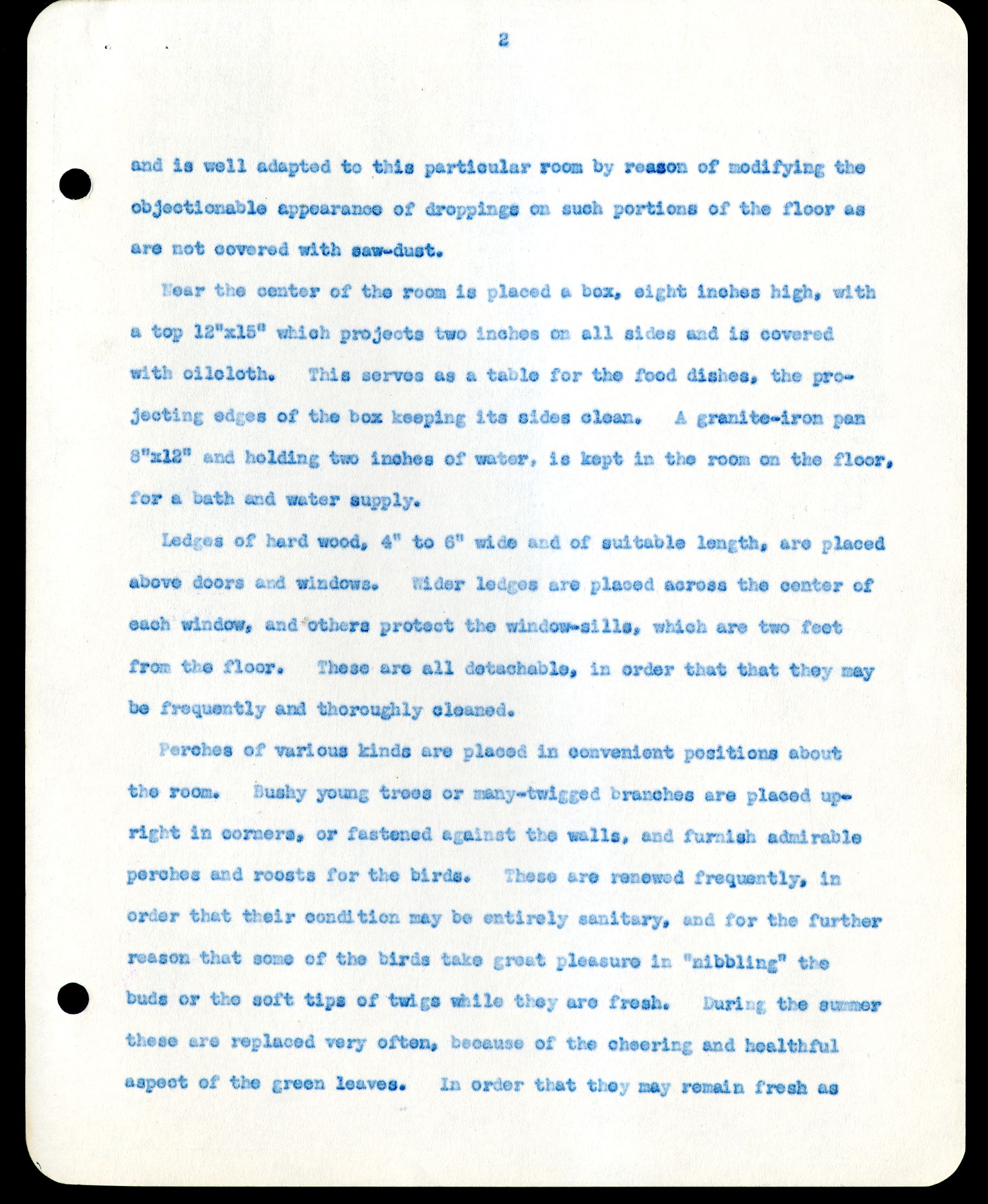
and is well adapted to this particular room by reason of modifying the objectionable appearance of droppings on such portions of the floor as are not covered with saw dust.
Near the center of the room is placed a box, eight inches high, with a top 12”x15” which projects two inches on all sides and is covered with oilcloth. This serves as a table for the food dishes, the projecting edges of the box keeping its sides clean. A granite-iron pan 8”x12” and holding two inches of water, is kept in the room on the floor, for a bath and water supply.
Ledges of hard wood, 4” to 6” wide and of suitable length, are placed above doors and windows. Wider ledges are placed across the center of each window, and others protect the window-sills, which are two feet from the floor. These are all detachable, in order that that they may be frequently and thoroughly cleaned.
Perches of various kinds are placed in convenient positions about the room. Bushy young trees or many twigged branches are placed upright in corners, or fastened against the walls, and furnish admirable perches and roosts for the birds. These are renewed frequently, in order that their condition may be entirely sanitary, and for the further reason that some of the birds have taken great pleasure in “nibbling” the buds or the soft tops of twigs while they are fresh. During the summer these are replaced very often, because of the cheering and healthful aspect of the green leaves. In order that they may remain fresh as

long as possible the butts are set in two-quart glass jars which are kept filled with water; a cottonwood branch or sapling so treated will retain its vigor for several days, while without water, the leaves will wilt within an hour. Fortunately, vacant lots near by afford almost a forest of cottonwoods from five to ten feet high. – The experiment was ventured – once only! – of placing potted plants and shrubs in the room; but within a week a dozen plants were broken and riddled, and in some cases utterly demolished; so the plan was regretfully abandoned.
Other perching places were provided, a prime favorite with the birds being a light ladder seven feet high and ten inches wide, with numerous hardwood rounds adapted to the size of the birds’ feet; this is placed with its foot against the food table and its top against the wall, the slope being about 45 degrees. The birds seem to enjoy hopping up this ladder as fast as they can go. – There is also a “visiting porch,” as we call it – a round bit of hardwood eight inches long which is inserted horizontally in the cross-piece of the screen door. Its name derives from the habit of practically all of the birds of perching upon it, to view our activities – one bird at a time, please! We have viewed some lively rows over possession of that post of honor. – Various swinging perches have been placed experimentally now and then, but the birds seem to care little for them.
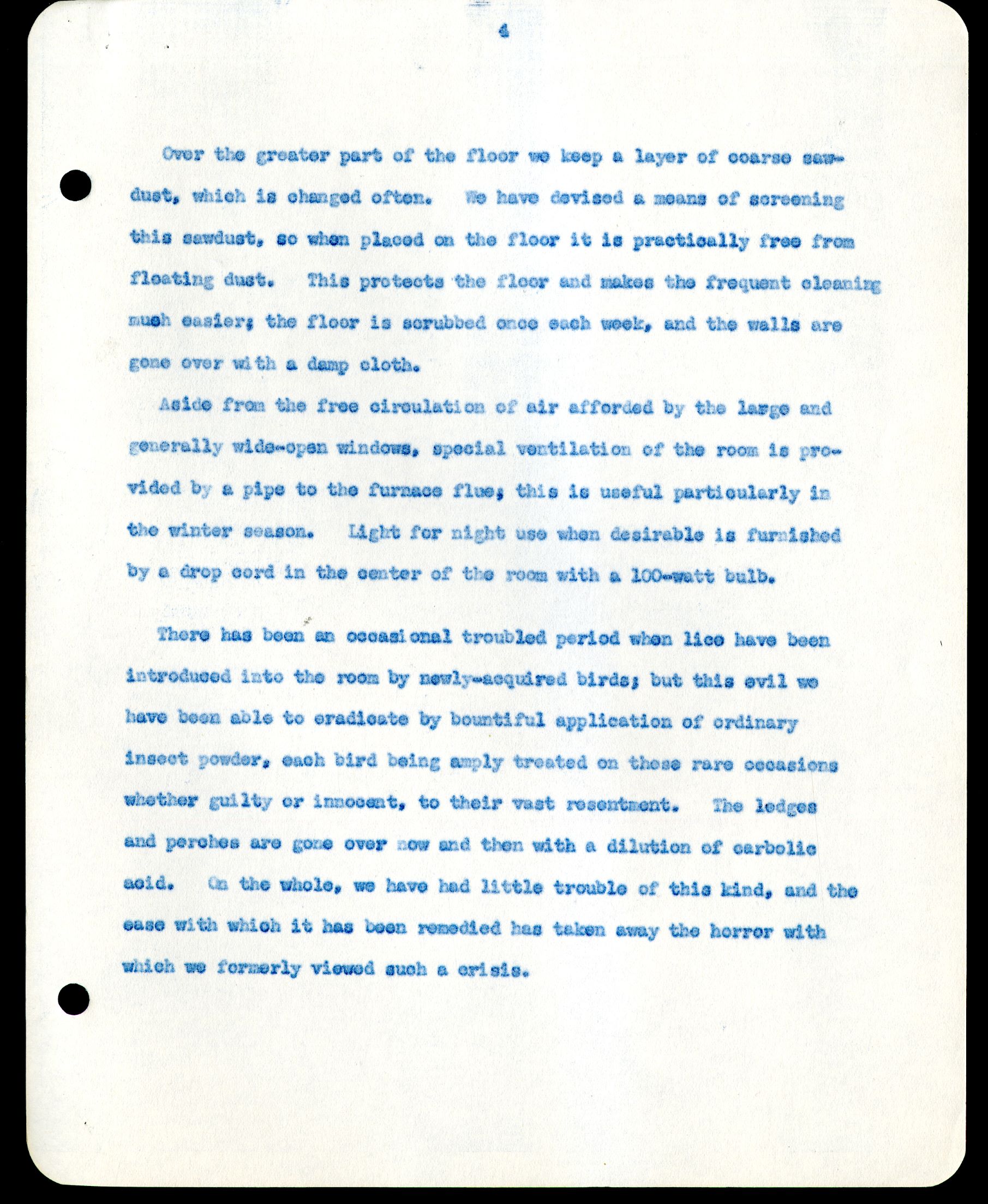
Over the greater part of the floor we keep a layer of coarse sawdust, which is changed often. We have devised a means of settling this saw dust, so when placed on the floor it is practically free from floating dust. This protects the floor and makes the frequent cleaning much easier; the floor is scrubbed once each week, and the walls are gone over with a damp cloth.
Aside from the free circulation of air afforded by the large and generally wide-open window, special ventilation of the room is provided by a pipe to the furnace flue; this is useful particularly in the winter season. Light for night use when desirable is furnished by a drop cord in the center of room with a 100-watt bulb.
There has been an occasional troubled period when lice have been introduced into the room by newly-acquired birds; but this evil we have been able to eradicate by bountiful application of ordinary insect power, each bird being amply treated on those rare occasions whether guilty or innocent, to their vast resentment. The ledges and perches are gone over now and then with a dilution of carbolic acid. On the whole, we have had little trouble of this kind, and the ease with which it has been remedied has taken away the horror with which we formerly viewed such a crisis.
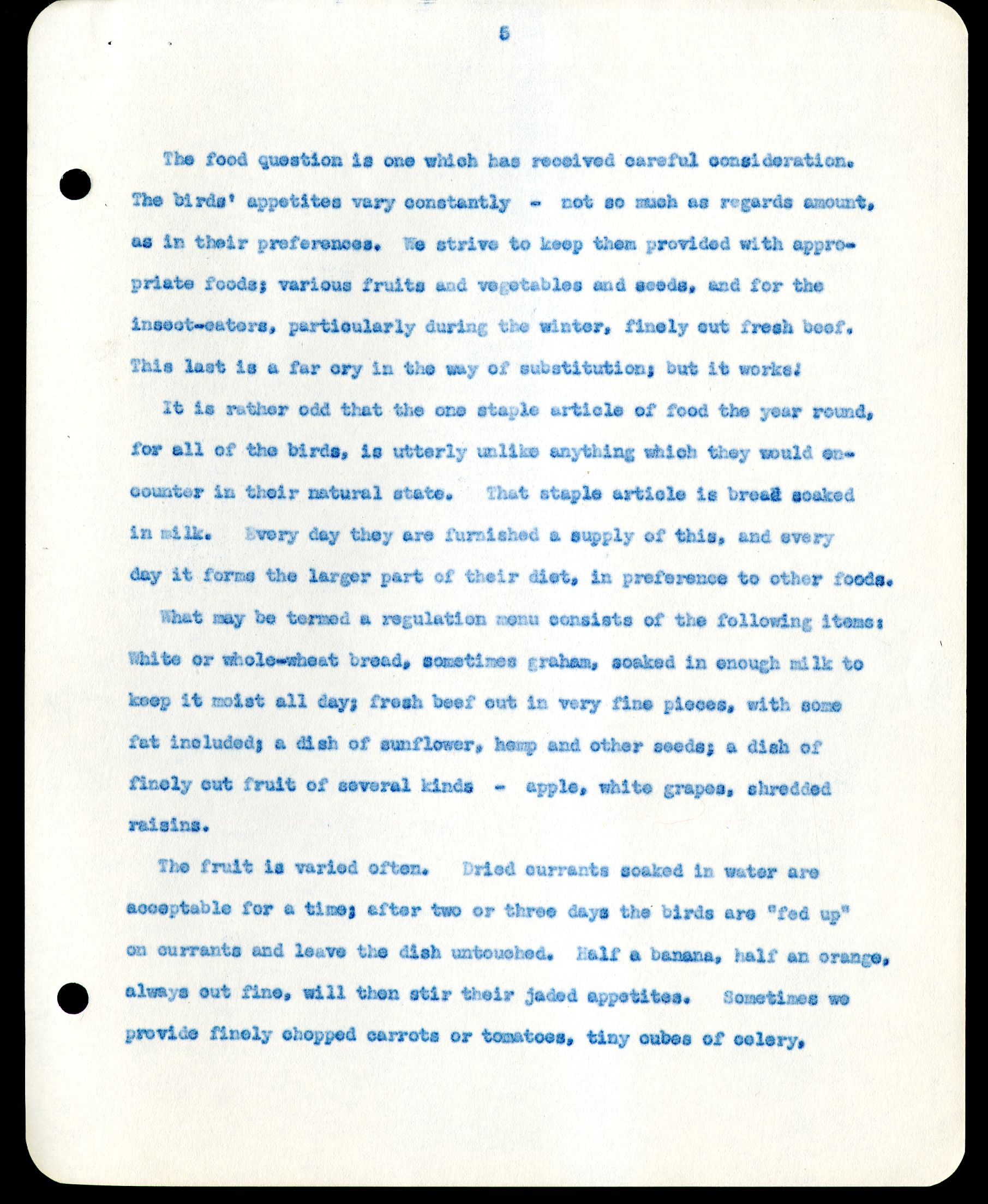
The food question is one which has received careful consideration. The birds’ appetites vary constantly – not so much as regards amount, as in their preferences. We strive to keep them provided with appropriate foods; various fruits and vegetables and seeds, and for the insect-eaters, particularly during the winter, finely cut fresh beef. This last is a far cry in the way of substitution; but it works!
It is rather odd that the one staple article of food the year round, for all of the birds, is utterly unlike anything which they would encounter in their natural state. That staple article is bread soaked in milk. Every day they are furnished a supply of this, and every day it forms the larger part of their diet, in preference to other foods.
What may be termed a regulation menu consists of the following items: White or whole-wheat bread, sometimes graham, soaked in enough milk to keep it moist all day; fresh beef cut in very fine pieces, with some fat included; a dish of sunflower, hemp and other seeds; a dish of finely cut fruit of several kinds – apple, white grapes, shredded raisins.
The fruit is varied often. Dried currants soaked in water are acceptable for a time; after two or three days the birds are “fed up” on currants and leave the dish untouched. Half a banana, half an orange, always out fine, will then stir their jaded appetites. Sometimes we provide finely chopped carrots or tomatoes, tiny cubes of celery,

shreds of lettuce. In the autumn, bittersweet-berries, coral-berries, and wild grapes, are acceptable. A hard-boiled egg, crushed very fine with a fork and sprinkled with red pepper, is a good appetizer.
In summer-time insects are easily procured; a few sweeps with a butterfly net among the clover or weed-tops will furnish a fine supply of grasshoppers, moths, beetles, spiders, flies, bugs, and larvae. There is a wild scramble when the out-turned net with this wealth of goodies is placed on the floor.
Grubs and larvae are great dainties. Cockroaches from logs in a small wooded lot near by are relished. Not one of the birds at present in the room will have anything to do with angle-worms – the robin’s specialty.
Large decumbent weeds such as purslane and prostrate amaranth are carefully lifted and carried into the bird-room, and as they teem with insect life they are earnestly investigated.
“Meal-worms” – the larval form of certain tenebrionid beetles – are sold by bird-stones at fifty cents per hundred, and are of great value in restoring an insectivorous bird which goes “off its feed” in the winter. We started our own colonies of these “worms” in screened pails of mixed flour, bran and corn meal in the basement, and the present population runs into the thousands. We are probably the wormiest householders in the county; but we carry the unadvertised honor modestly.
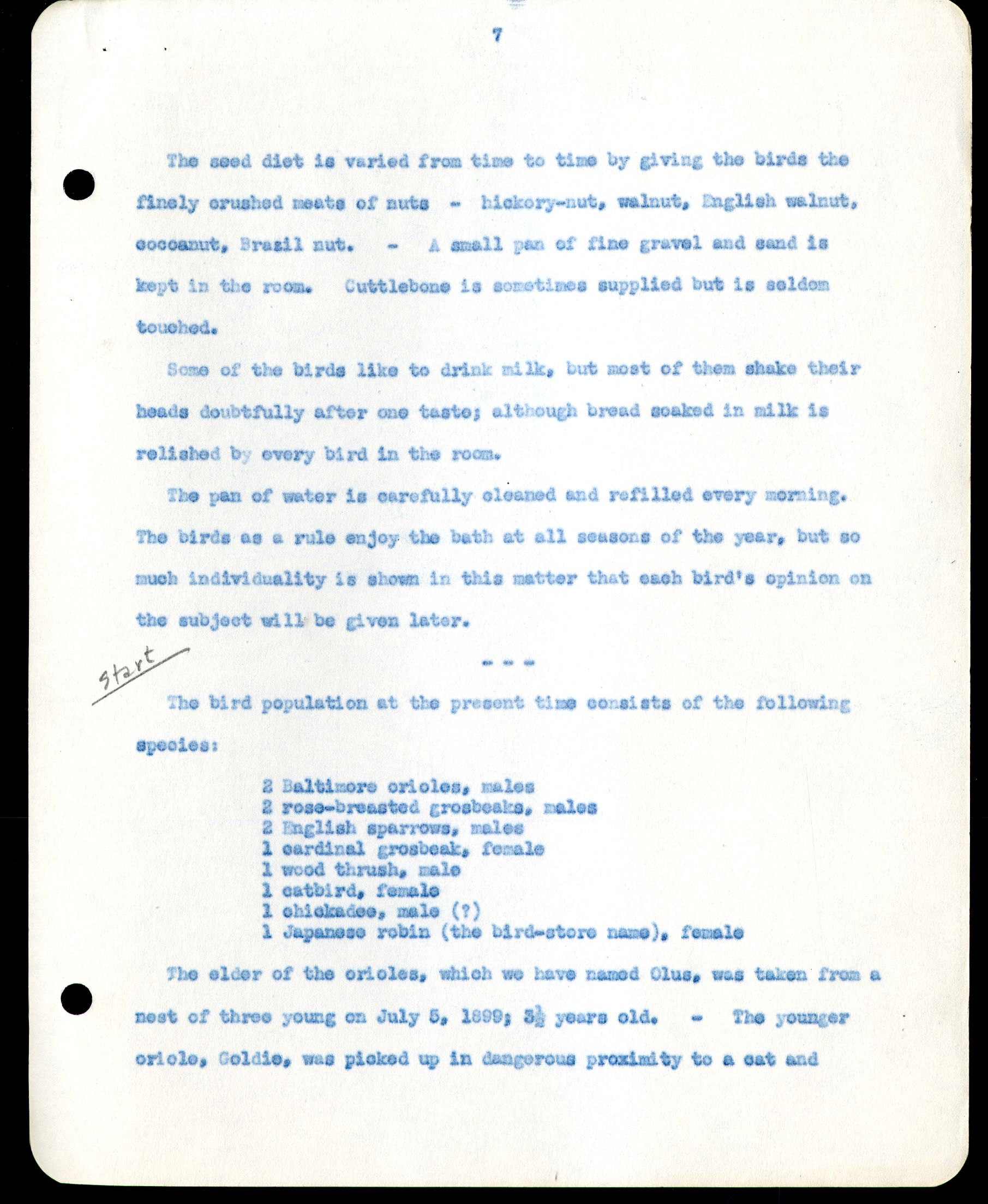
The seed diet is varied from time to time by giving the birds the finely crushed meats of nuts – hickory-nut, walnut, English walnut, cocoanut, Brazil nut. – A small pan of fine gravel and sand is kept in the room. Cuttlebone is sometimes supplied but is seldom touched.
Some of the birds like to drink milk, but most of them shake their heads doubtfully after one taste; although bread soaked in milk is relished by every bird in room.
The pan of water is carefully cleaned and refilled every morning. The birds as a rule enjoy the bath at all seasons of the year, but so much individuality is shown in this matter that each bird’s opinion on the subject will be given later.
—
The bird population at the present time consists of the following species:
2 Baltimore orioles, males 2 rose-breasted grosbeaks, males 2 English sparrows, males 1 cardinal grosbeak, female 1 wood thrush, male 1 catbird, female 1 chickadee, male (?) 1 Japanese robin (the bird-store name), female
The elder of the orioles, which we have named Olus, was taken from a nest of three young on July 5, 1899; 3½ years old. – The younger oriole, Goldie, was picked up in dangerous proximity to a cat and
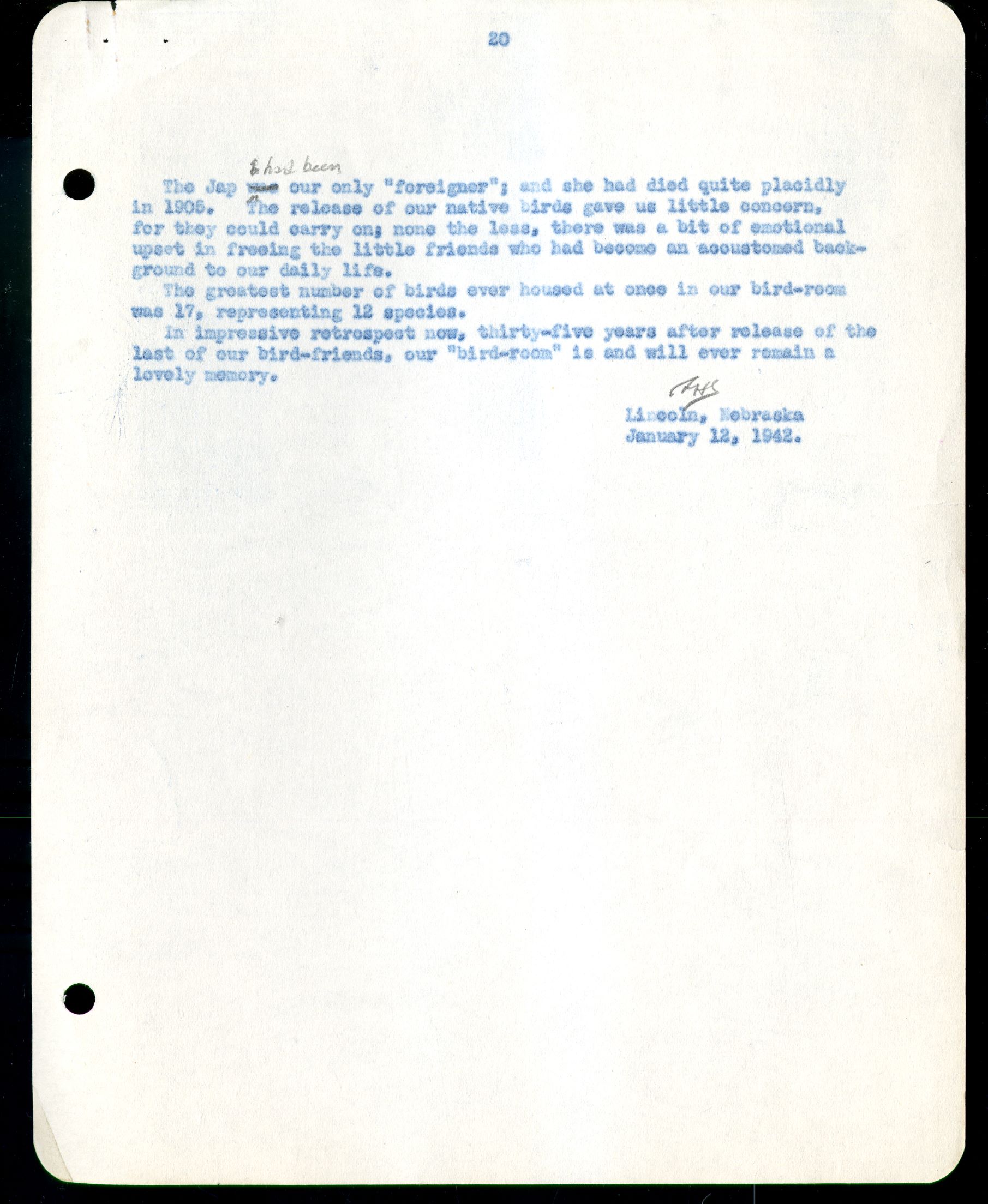
The Jap was had been our only “foreigner”; and she had died quite placidly in 1905. The release of our native birds gave us little concern, for they could carry on; none the less, there was a bit of emotional upset in freeing the little friends who had become an accustomed background to our daily life.
The greatest number of birds ever housed at once in our bird-room was 17, representing 12 species.
In impressive retrospect now, thirty-five years after release of the last of our bird-friends, our “bird-room” is and will ever remain a lovely memory.
FHS Lincoln, Nebraska January 12, 1942
Detailed Account of Eleven Birds
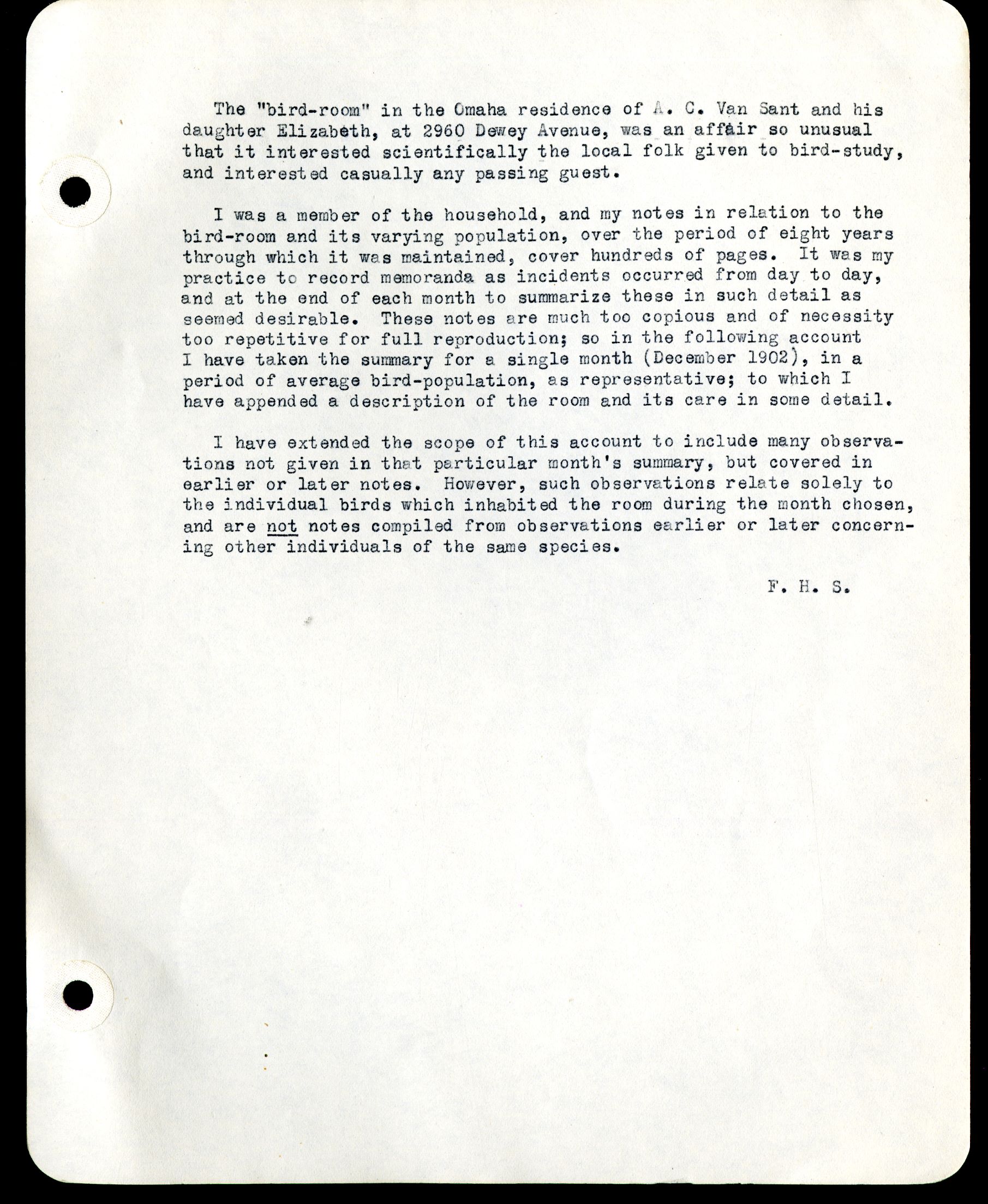 The “bird-room” in the Omaha residence of A.C. Van Sant and his daughter Elizabeth – at 2960 Dewey Avenue – was a domestic appendage so unusual, that it interested scientifically the local folk given to bird-study, and interested casually any passing guest.
The “bird-room” in the Omaha residence of A.C. Van Sant and his daughter Elizabeth – at 2960 Dewey Avenue – was a domestic appendage so unusual, that it interested scientifically the local folk given to bird-study, and interested casually any passing guest.
I was a member of the household, and my notes in relation to the bird-room and its varying population, over the period of eight years through which it was maintained, cover hundreds of pages. It was my practice to record memoranda as incidents occurred from day to day, and at the end of each month to summarize these in such detail as seemed desirable. These notes are much too copious and of necessity too repetitive for full reproduction; so in the following account I have taken the summary for a single month (December 1902), in a period of average bird-population, as representative; to which I have appended a description of the room and its care in some detail.
I have extended the scope of this account to include many observations not given in that particular month’s summary, but covered in earlier or later notes. However, such observations relate solely to the individual birds which inhabited the room during the month chosen, and are not notes compiled from observations earlier or later concerning other birds of the same species.
F. H. S.
 The bird population at the present time consists of the following species:
The bird population at the present time consists of the following species:
2 Baltimore orioles, males 2 rose-breasted grosbeaks, males 2 English sparrows, males 1 cardinal grosbeak, female 1 wood thrush, male 1 catbird, female 1 chickadee, male (?) 1 Japanese robin (the bird-store name), female
The elder of the orioles, which we have named Olus, was taken from a nest of three young on July 5, 1899; 3½ years old. – The younger oriole, Goldie, was picked up in dangerous proximity to a cat and brought to us by a friend; now 1½ years old. The bird when found was barely old enough to make short flights. The home nest could not be located, as the parent birds were not seen.
The rose-breasted grosbeaks are brothers, taken from the nest early in July, 1900; now 2½ years old. They early and fairly earned their named: Dogan and Duffer. From the sixth week after their taking, we have been unable to distinguish one from the other except by careful scrutiny; no greater similarity would seem possible in tow birds as regards appearance, actions, habits, likes, dislikes, and vocal offerings. They are very sociable and follow each other about the whole time, in entire harmony except during the mating season, when each blames the other for not being a lady, and then they fight like pirates.
 The English sparrows – properly European House Sparrows; no are no more distinctively English than Spanish or Russian – were brought to us at different times in the spring of 1900; they will be 3 years old in May. They are both waifs from the pavement. They like each other pretty well, but without the devotion of the grosbeaks, and get along with the other birds most peacefully; in fact, we have never noted an instance of aggression on their part toward a bird in the room of another species, though it is obviously their natural program to pull plenty feathers from each other. It can not be said that they sing, but they certainly are vocal at all seasons of the year, and contribute much of the interest of the room during the great part of the year when most of the other birds are silent.
The English sparrows – properly European House Sparrows; no are no more distinctively English than Spanish or Russian – were brought to us at different times in the spring of 1900; they will be 3 years old in May. They are both waifs from the pavement. They like each other pretty well, but without the devotion of the grosbeaks, and get along with the other birds most peacefully; in fact, we have never noted an instance of aggression on their part toward a bird in the room of another species, though it is obviously their natural program to pull plenty feathers from each other. It can not be said that they sing, but they certainly are vocal at all seasons of the year, and contribute much of the interest of the room during the great part of the year when most of the other birds are silent.
The cardinal grosbeak has a peculiar history. She was brought to us two years ago the coming spring, a boy having found her in a vacant house. Whether she was left there by the occupants when they moved out, which would seem cruel beyond belief, or whether she got into the house from outside, which would seem highly improbable, we do not know. She was terribly in need of food and care; she was little more than a shadow, the keel of her sternum projecting like the prow of a boat. For days it was a question of mere survival, but under careful attention she gradually became strong and healthy, and is now one of our most handsome birds – large, well feathered, graceful, and, at least by contrast with the cut-ups in the room, dignified. She long puzzled
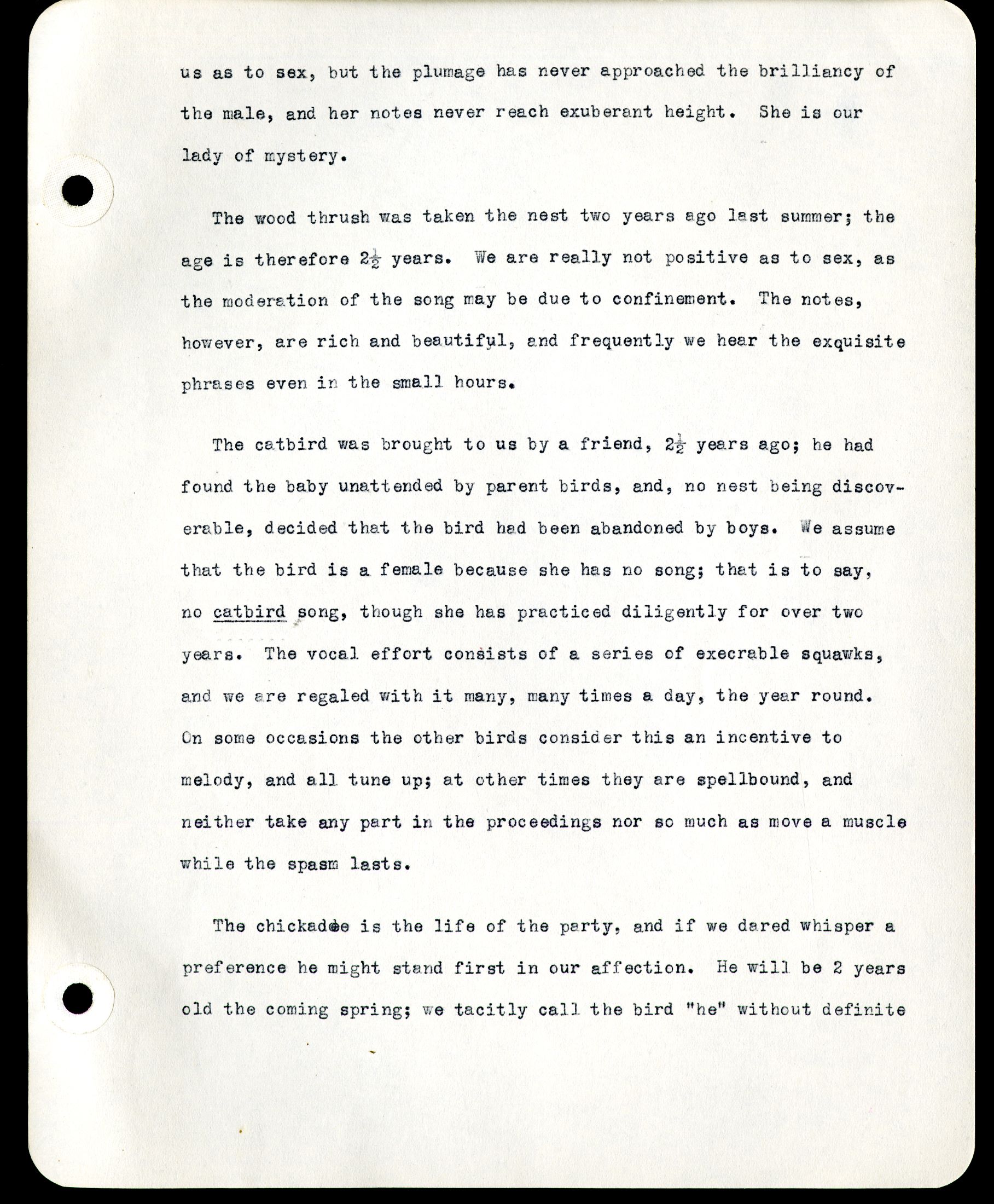 us as to sex, but the plumage has never approached the brilliancy of the male, and her notes never reach exuberant height. She is our lady of mystery.
us as to sex, but the plumage has never approached the brilliancy of the male, and her notes never reach exuberant height. She is our lady of mystery.
The wood thrush was taken the nest two years ago last summer; the age is therefore 2½ years. We are really not so positive as to sex, as the moderation of the song may be due to confinement. The notes, however, are rich and beautiful, and frequently we hear the exquisite phrases even in the small hours.
The catbird was brought to us by a friend, 2½ years ago; he had found the baby unattended by parent birds, and, no nest being discoverable, decided that the bird had been abandoned by boys. We assume that the bird is a female because she has no song; that is to say, no catbird song, though she has practiced diligently for over two years. The vocal effort consists of a series of execrable squawks, and we are regaled with it many, many times a day, the year round. On some occasions the other birds consider this an incentive to melody, and all tune up; at other times they are spellbound, and neither take any part in the proceedings nor so much as move a muscle while the spasm lasts.
The chickadee is the life of the party, and if we dared whisper a preference he might stand first in our affection. He will be 2 years old the coming spring; we tacitly call the bird “he” without definite
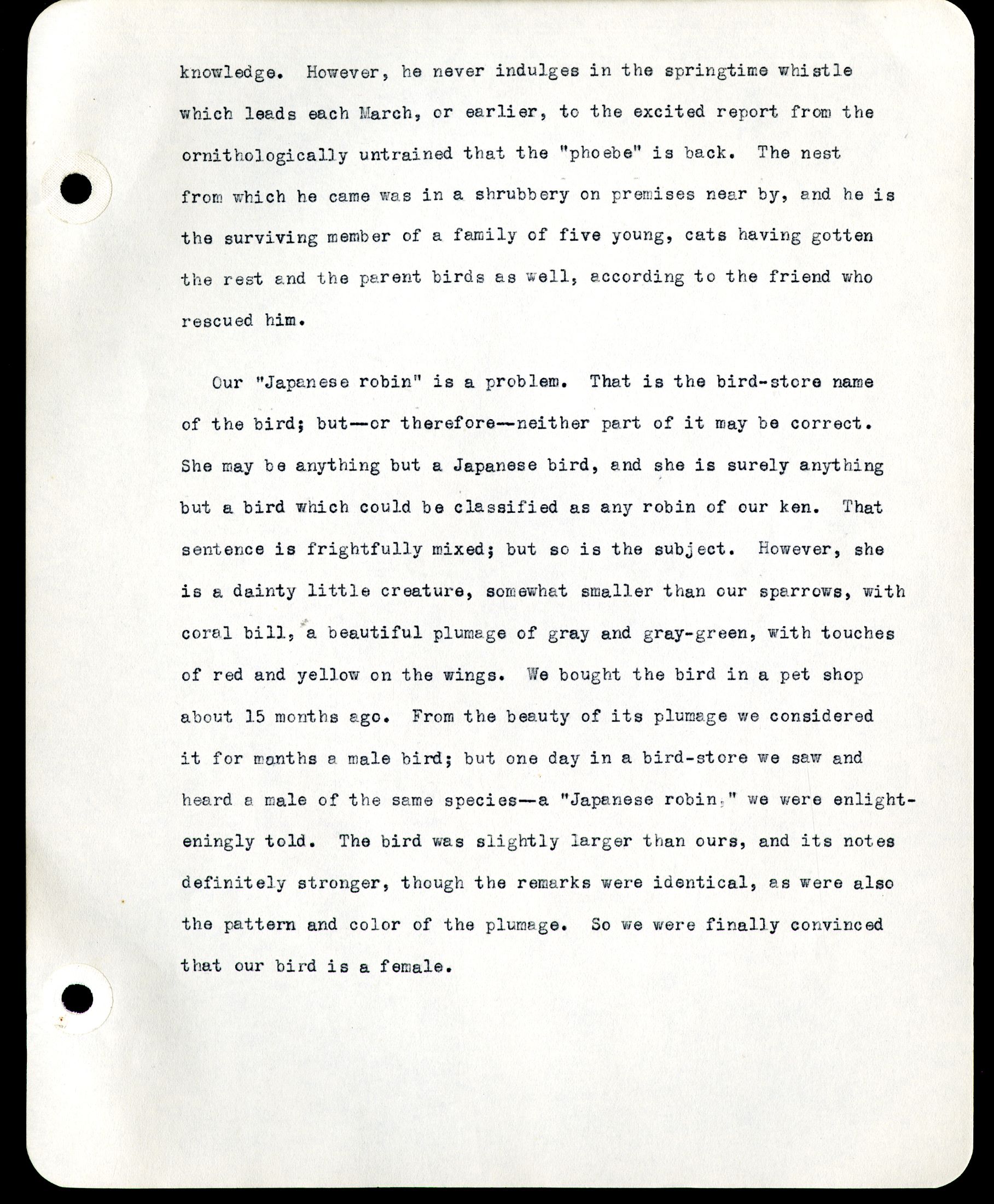 knowledge. However, he never indulges in the springtime whistle which leads each March, or earlier, to the excited report from the ornithologically untrained that the “phoebe” is back. The nest from which he came was in a shrubbery on premises near by, and he is the surviving member of a family of five young, cats having gotten the rest and the parent birds as well, according to the friend who rescued him.
knowledge. However, he never indulges in the springtime whistle which leads each March, or earlier, to the excited report from the ornithologically untrained that the “phoebe” is back. The nest from which he came was in a shrubbery on premises near by, and he is the surviving member of a family of five young, cats having gotten the rest and the parent birds as well, according to the friend who rescued him.
Our “Japanese robin” is a problem. That is the bird-store name of the bird; but – or therefore – neither part of it may be correct. She may be anything but a Japanese bird, and she is surely anything but a bird which could be classified as a robin of our ken. That sentence is frightfully mixed; but so is the subject. However, she is a dainty little creature, somewhat smaller than our sparrows, with coral bill, a beautiful plumage of gray and gray-green, with touches of red and yellow on the wings. We bought the bird in a pet shop about 15 months ago. From the beauty of its plumage we considered it for months a male bird; but one day in a bird-store we saw and heard a male of the same species – a “Japanese robin,” we were enlighteningly told. The bird was slightly larger than ours, and its notes definitely stronger, though the remarks were identical as were also the pattern and color of the plumage. So we were finally convinced that our bird is a female.
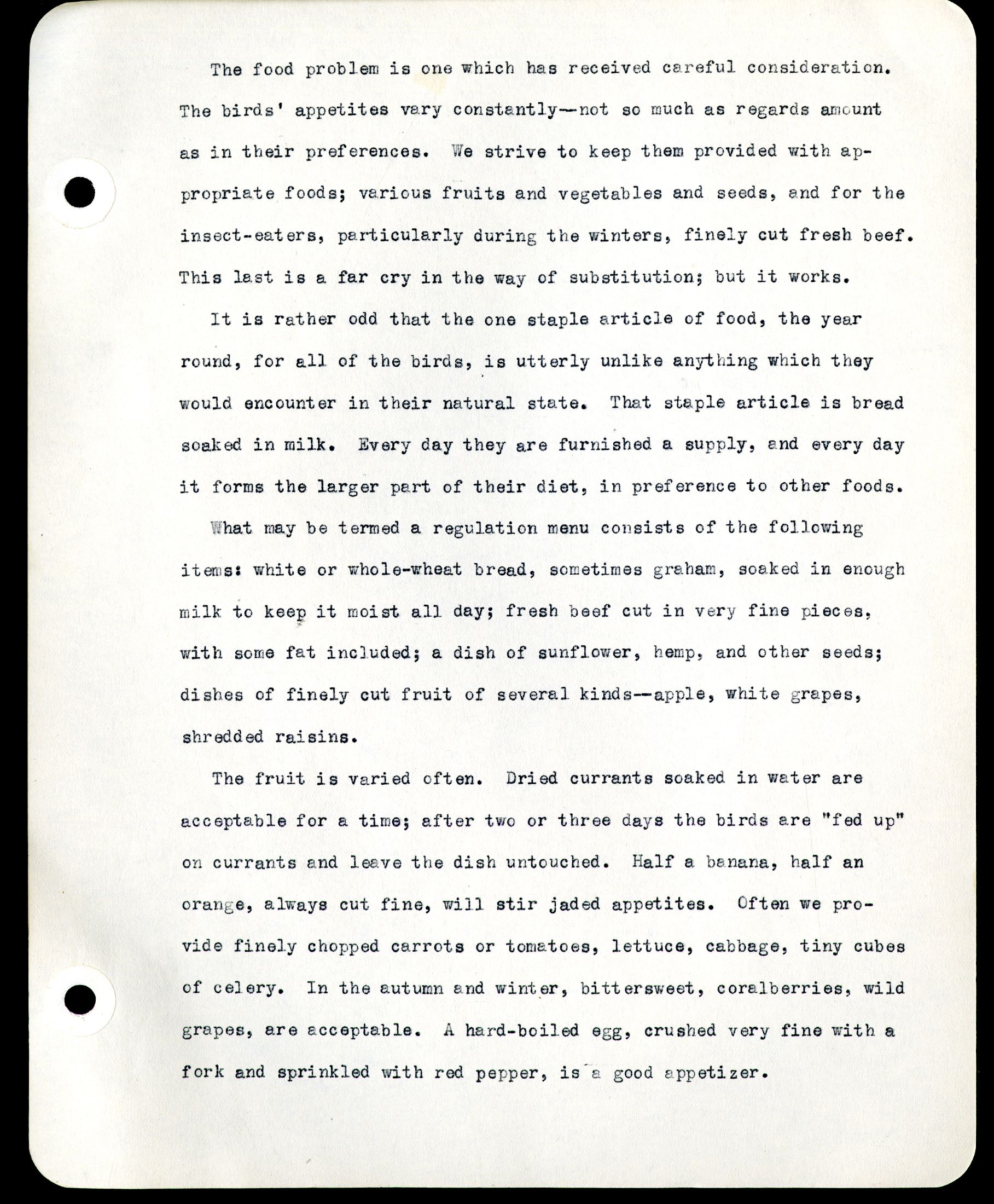 The food problem is one which has received careful consideration. The birds’ appetites vary constantly – not so much as regards amount as in their preferences. We strive to keep them provided with appropriate foods; various fruits and vegetables and seeds, and for the insect-eaters, particularly during the winters, finely cut fresh beef. This last is a far cry in the way of substitution; but it works. It is rather odd that the one staple article of food, the year round, for all of the birds, is utterly unlike anything which they would encounter in their natural state. That staple article is bread soaked in milk. Every day they are furnished a supply, and every day it forms the larger part of their diet, in preference to other foods.
The food problem is one which has received careful consideration. The birds’ appetites vary constantly – not so much as regards amount as in their preferences. We strive to keep them provided with appropriate foods; various fruits and vegetables and seeds, and for the insect-eaters, particularly during the winters, finely cut fresh beef. This last is a far cry in the way of substitution; but it works. It is rather odd that the one staple article of food, the year round, for all of the birds, is utterly unlike anything which they would encounter in their natural state. That staple article is bread soaked in milk. Every day they are furnished a supply, and every day it forms the larger part of their diet, in preference to other foods.
What may be termed a regulation menu consists of the following items: white or whole-wheat bread, sometimes graham, soaked in enough milk to keep it moist all day; fresh beef cut in very fine pieces, with some fat included; a dish of sunflower, hemp, and other seeds; dishes of finely cut fruit of several kinds – apple, white grapes, shredded raisins. The fruit is varied often. Dried currants soaked in water are acceptable for a time, after two or three days the birds are “fed up” on currants and leave the dish untouched. Half a banana, half an orange, always cut fine, will stir jaded appetites. Often we provide finely chopped carrots or tomatoes, lettuce, cabbage, tiny cubes of celery. In the autumn and winter, bittersweet, coralberries, wild grapes, are acceptable. A hard-boiled egg, crushed very fine with a fork and sprinkled with red pepper, is a good appetizer.
 In summer-time insects are easily procured; a few sweeps with a butterfly net among the clover or weed-tops will furnish a fine supply of grasshoppers, moths, beetles, spiders, flies, bugs, and larvae. There is a wild scramble when the out-turned net with this wealth of goodies is placed on the floor.
In summer-time insects are easily procured; a few sweeps with a butterfly net among the clover or weed-tops will furnish a fine supply of grasshoppers, moths, beetles, spiders, flies, bugs, and larvae. There is a wild scramble when the out-turned net with this wealth of goodies is placed on the floor.
Grubs and larvae are great dainties. Cockroaches from logs in a small wooded lot near by are relished. Not one of the birds at present in the room will have anything to do with angle-worms – the robin’s specialty.
Large decumbent weeds such as purslane and prostrate amaranth are carefully lifted and carried into the bird-room, and as they teem with insect life they are earnestly investigated.
“Meal-worms” – the larval form of certain tenebrionid beetles – are sold by bird-stones at fifty cents per hundred, and are of great value in restoring an insectivorous bird which goes “off its feed” in the winter. We started our own colonies of these “worms” in screened pails of mixed flour, bran and corn meal in the basement, and the present population runs into the thousands. We are probably the wormiest householders in the county; but we carry the unadvertised honor modestly.
The seed diet is varied from time to time by giving the birds the finely crushed meats of nuts – hickory-nut, walnut, English walnut, cocoanut, Brazil nut. – A small pan of fine gravel and sand is kept in the room. Cuttlebone is sometimes supplied but is seldom touched.
 Some of the birds like to drink milk, but most of them shake their heads doubtfully after one taste; although bread soaked in milk is relished by every bird in room.
Some of the birds like to drink milk, but most of them shake their heads doubtfully after one taste; although bread soaked in milk is relished by every bird in room.
The pan of water is carefully cleaned and refilled every morning. The birds as a rule enjoy the bath at all seasons of the year, but so much individuality is shown in this matter that each bird’s opinion on the subject will be given later.
There has been an occasional troubled period when lice have been introduced into the room by newly-acquired birds; but this evil we have been able to eradicate by bountiful application of ordinary insect power, each bird being amply treated on those rare occasions whether guilty or innocent, to their vast resentment. The ledges and perches are gone over now and then with a dilution of carbolic acid. On the whole, we have had little trouble of this kind, and the ease with which it has been remedied has taken away the horror with which we formerly viewed such a crisis.
As regards friendliness of the birds toward ourselves, we have purposefully never made any attempt to tame or train them, greatly preferring to have them remain their natural selves. Notwithstanding, some of the birds are very friendly with us. Both orioles come to us freely, perching on hand, shoulder, or head. The catbird, while not so amenable, has no fear of us. The wood thrush will take dainties from our fingers, but dashes off with the booty. On rare occasions
 the grosbeaks, the carinal, and the Jap, have been tempted to take food from a plate held in our hands. The sparrows are so self-centered and so busy with plots and feuds (against each other only) that in the main they treat us will chilling indifference.
the grosbeaks, the carinal, and the Jap, have been tempted to take food from a plate held in our hands. The sparrows are so self-centered and so busy with plots and feuds (against each other only) that in the main they treat us will chilling indifference.
The chickadee is positively fearless, and obviously likes us as playmates. Frequently one of use goes into the room and takes a seed from the dish – to which, of course, he has had access all day; he comes for it like a shot, and generally chooses a finger as the proper place for breaking the seed. He holds it firmly with his feet, and hammers away with blows which would ruin a toe if they varied from accuracy by the tiniest fraction of an inch.
He has a deal of curiosity about our clothing, which I presume he considers our bark; which, after all, is a passable definition. He likes to climb about and explore buttonholes and vest pockets, or ribbons and lace, as the case may be. Probably he is hoping for worms or larvae in this odd bark; and while, on reflection, this innuendo might be reasonably resented as a general proposition, we take it joyfully from him. He is a wonderful acrobat and equilibrist, landing on practically nothing and clinging there with ease, and is quite as happy upside down as in an attitude which conservatives would smugly define as right.
Sometimes I take up some hemp seeds and extend my arm invitingly. Of course, he arrives. But instead of opening my hand as an open-handed gentleman would, I keep the fingers lightly closed, so that he
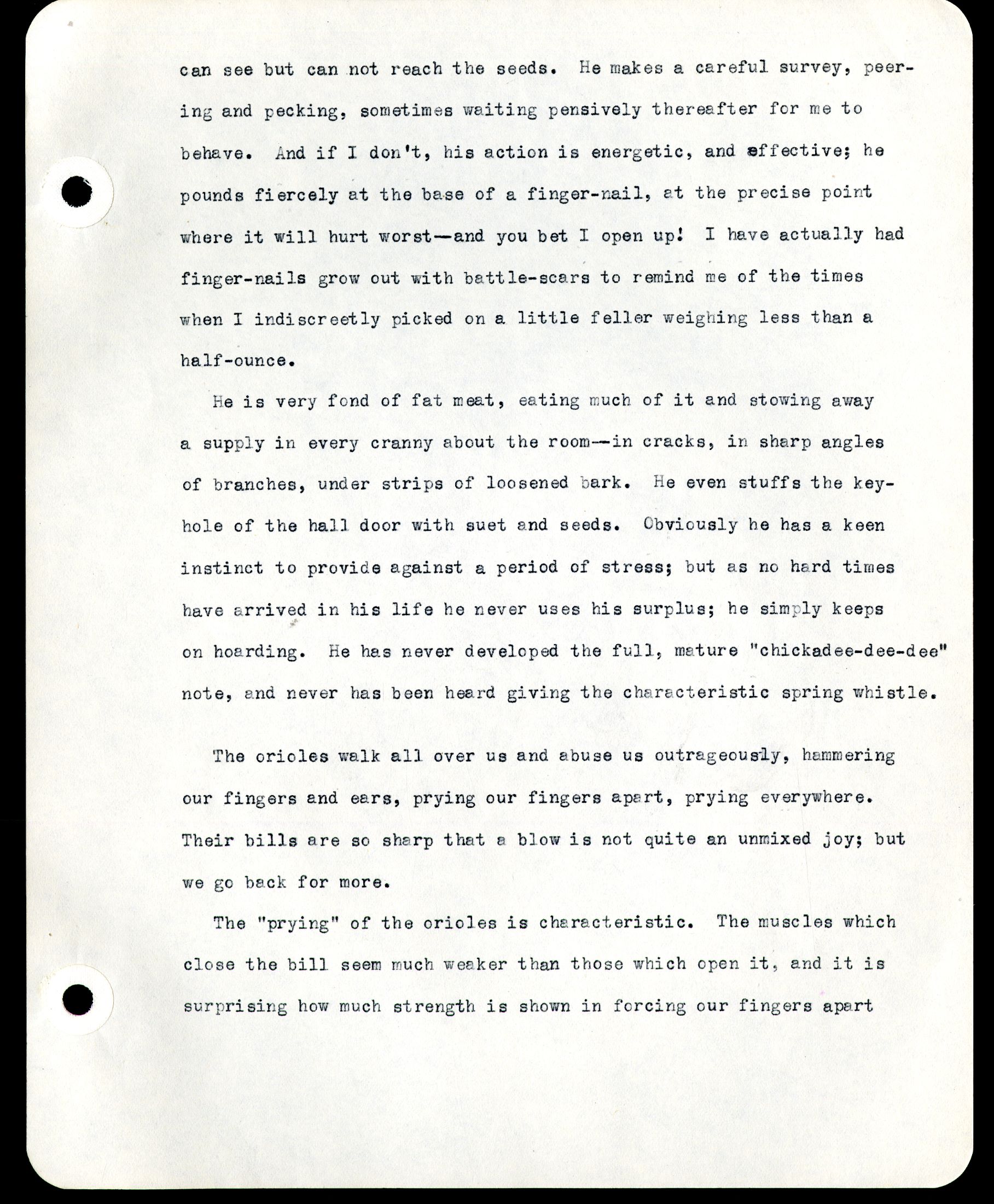 can see but can not reach the seeds. He makes careful survey, peering and pecking, sometimes waiting pensively thereafter for me to behave. And if I don’t, his action is energetic, and effective; he pounds fiercely at the base of a finger-nail, at the precise point where it will hurt worst – and you bet I open up! I have actually had finger-nails grow out with battle-scars to remind me of the times when I indiscreetly picked on a little feller weighing less than a half-ounce.
can see but can not reach the seeds. He makes careful survey, peering and pecking, sometimes waiting pensively thereafter for me to behave. And if I don’t, his action is energetic, and effective; he pounds fiercely at the base of a finger-nail, at the precise point where it will hurt worst – and you bet I open up! I have actually had finger-nails grow out with battle-scars to remind me of the times when I indiscreetly picked on a little feller weighing less than a half-ounce.
He is very fond of fat meat, eating much of it and stowing away a supply in every cranny about the room – in cracks, in sharp angles of branches, under strips of loosened bark. He even stuffs the key-hole of the hall door with suet and seeds. Obviously he has a keen instinct to provide against a period of stress; but as no hard times have arrived in his life he never uses his surplus; he simply keeps on hoarding. He has never developed the full, mature, “chickadee-dee-dee” note, and never has been heard giving the characteristic spring whistle.
The orioles walk all over us and abuse us outrageously, hammering our fingers and ears, prying our fingers apart, prying everywhere. Their bills are so sharp that a blow is not quite an unmixed joy; but we got back for more.
The “prying” of the orioles is characteristic. The muscles which close the bill seem much weaker than those which open it, and it is surprising how much strength is shown in forcing our fingers apart
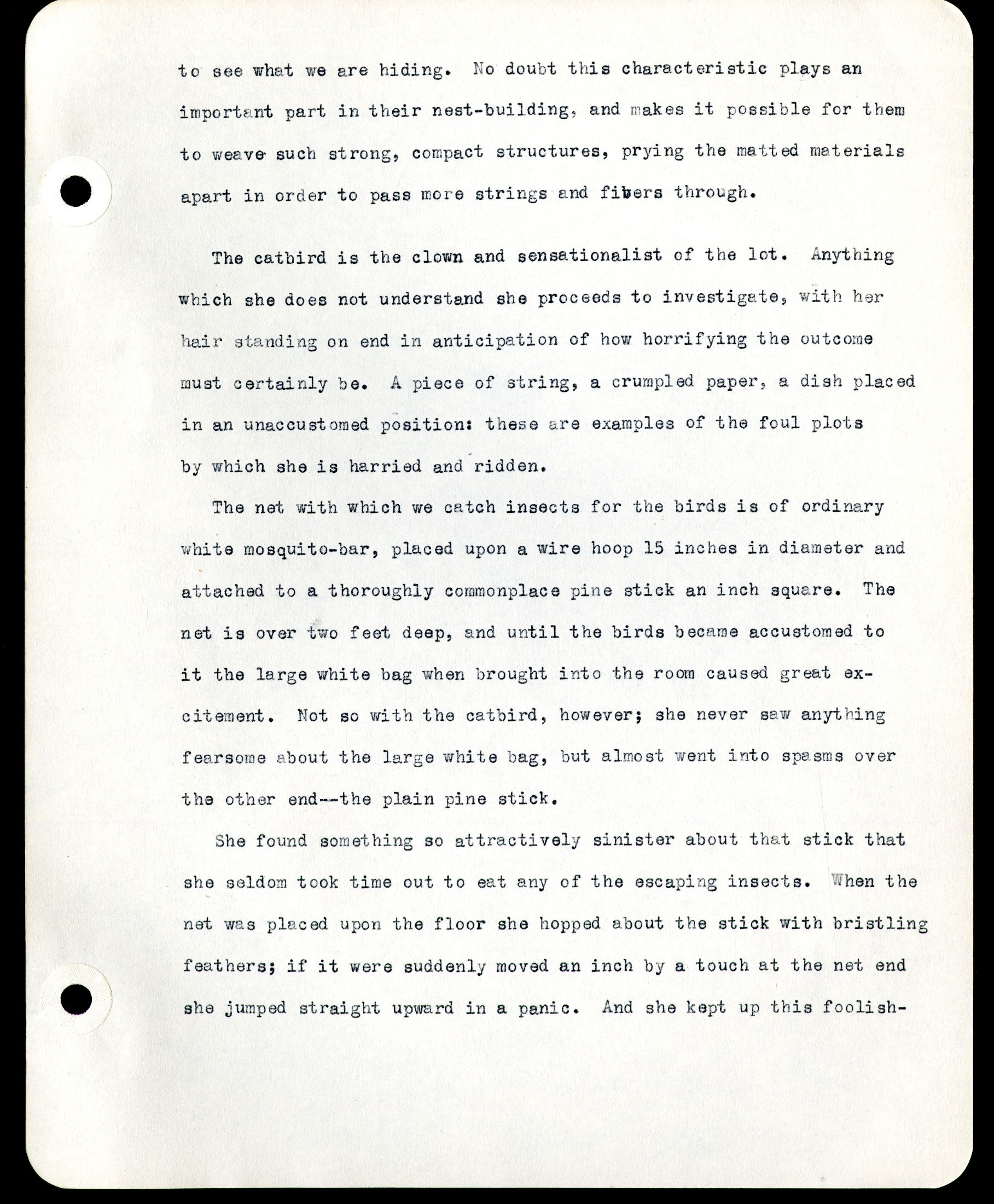 to see what we are hiding. No doubt this characteristic plays an important part in their nest-building, and makes it possible for them to weave such strong, compact structures, prying the matted materials apart in order to pass more strings and fibers through.
to see what we are hiding. No doubt this characteristic plays an important part in their nest-building, and makes it possible for them to weave such strong, compact structures, prying the matted materials apart in order to pass more strings and fibers through.
The catbird is the clown and sensationalist of the lot. Anything which she does not understand she proceeds to investigate, with her hair standing on end in anticipation of how horrifying the outcome must certainly be. A piece of string, a crumpled paper, a dish placed in an unaccustomed position: these are examples of the foul plots by which she is harried and ridden.
The net with which we catch insects for the birds is of ordinary white mosquito-bar, placed upon a wire hoop 15 inches in diameter and attached to a thoroughly commonplace pine stick an inch square. The net is over two feet deep, and until the birds become accustomed to it the large white bag when brought into the room caused great excitement. Not so with the catbird, however; she never saw anything fearsome about the large white bag, but almost went into spasms over the other end – the plain pine stick.
She found something so attractively sinister about that stick that she seldom took time out to eat any of the escaping insects. When the net was placed upon the floor she hopped about the stick with bristling feathers; if it were suddenly moved an inch by a touch at the net end she jumped straight upward in a panic. And she kept up this foolish-
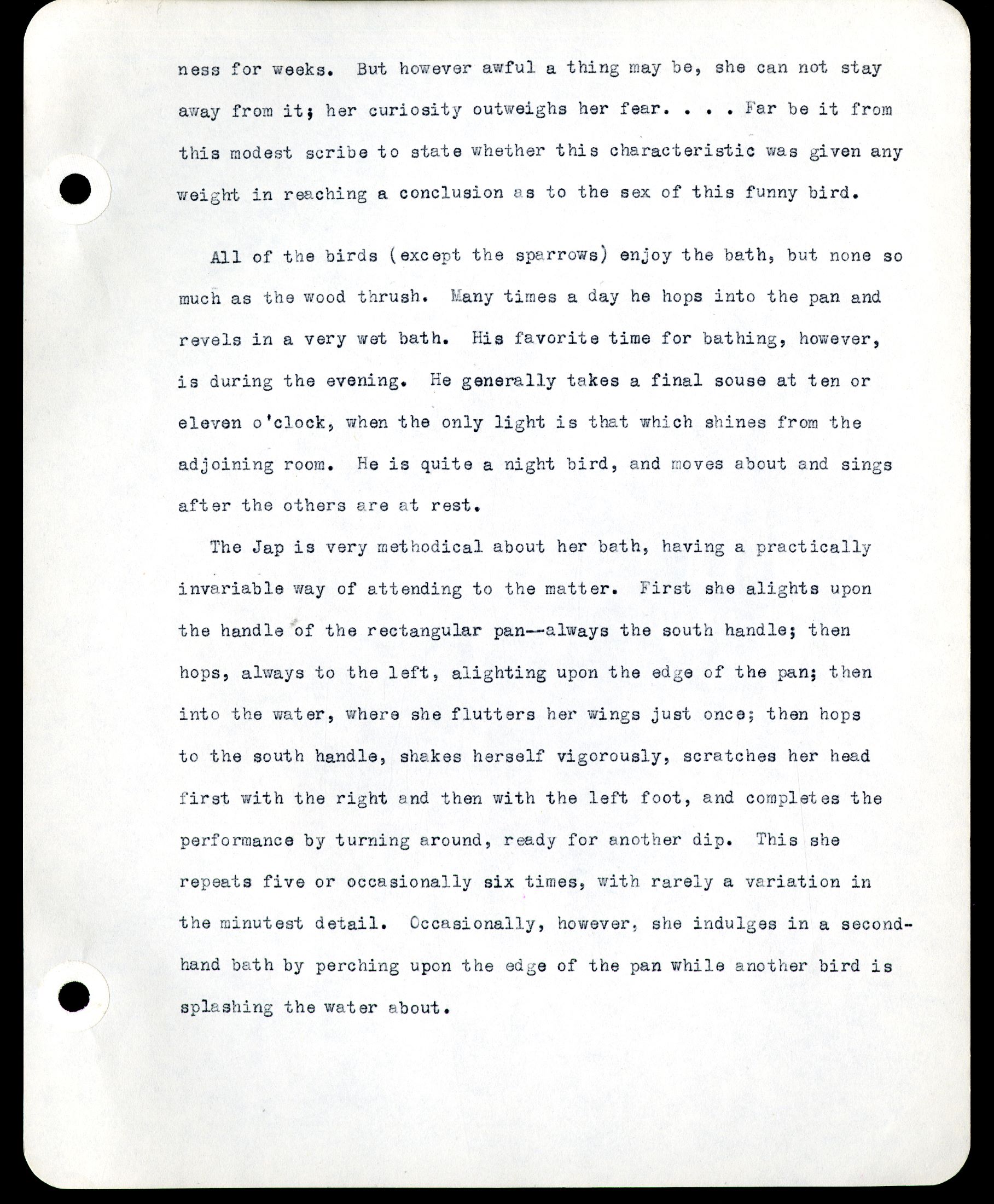 ness for weeks. But however awful a thing may be, she can not stay away from it; her curiosity outweighs her fear. . . . Far be it from this modest scribe to state whether this characteristic was given any weight in reaching a conclusion as to the sex of this funny bird.
ness for weeks. But however awful a thing may be, she can not stay away from it; her curiosity outweighs her fear. . . . Far be it from this modest scribe to state whether this characteristic was given any weight in reaching a conclusion as to the sex of this funny bird.
All of the birds (except the sparrows) enjoy the bath, but none so much as the wood thrush. Many times a day he hops into the pan and revels in a very wet bath. His favorite time for bathing, however, is during the evening. He generally takes a final souse at ten or eleven o’clock, when the only light is that which shines from the adjoining room. He is quite a night bird, and moves about and sings after the others are at rest.
The Jap is very methodical about her bath, having a practically invariable way of attending to the matter. First she alights upon the handle of the rectangular pan – always the south handle; then hops, always to the left, alighting upon the edge of the pan; then into the water, where she flutters her wings just once; then hopes to the south handle, shakes herself vigorously, scratches her head first with the right and then with the left foot, and completes the performance by turning around, ready for another dip. This she repeats five or occasionally six times, with rarely a variation in the minutest detail. Occasionally, however, she indulges in a second-hand bath by perching upon the edge of the pan while another bird is splashing the water about.
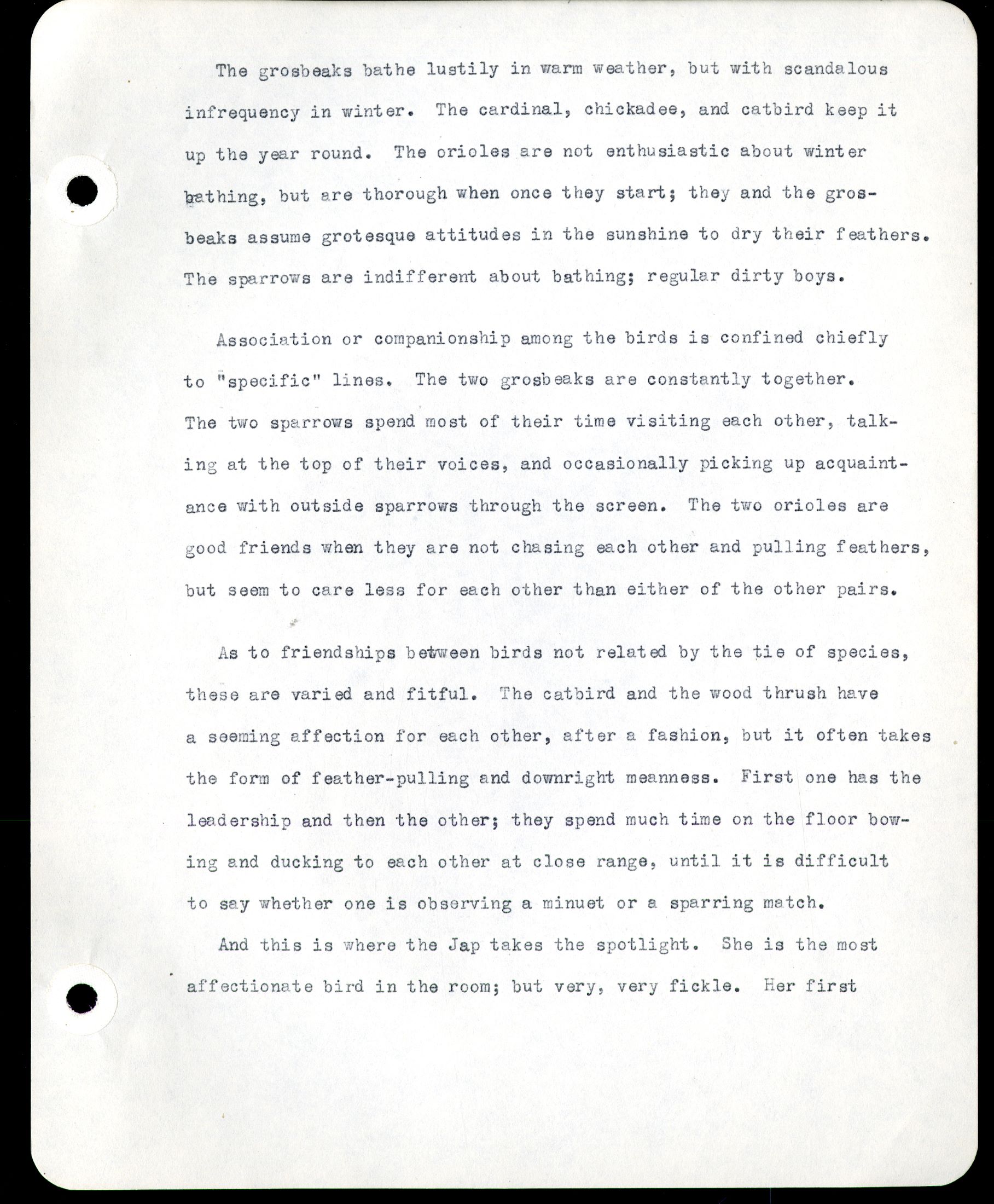 The grosbeaks bathe lustily in warm weather, but with scandalous infrequency in winter. The cardinal, chickadee, and catbird keep it up the year round. The orioles are not enthusiastic about winter bathing, but are through when once they start; they and the grosbeaks assume grotesque attitudes in the sunshine to dry their feathers. The sparrows are indifferent about bathing; regular dirty boys.
The grosbeaks bathe lustily in warm weather, but with scandalous infrequency in winter. The cardinal, chickadee, and catbird keep it up the year round. The orioles are not enthusiastic about winter bathing, but are through when once they start; they and the grosbeaks assume grotesque attitudes in the sunshine to dry their feathers. The sparrows are indifferent about bathing; regular dirty boys.
Association or companionship among the birds is confined chiefly to “specific” lines. The two grosbeaks are constantly together. The two sparrows spend most of their time visiting each other, talking at the top of their voices, and occasionally picking up acquaintance with outside sparrows through the screen. The two orioles are good friends when they are not chasing each other and pulling feathers, but seem to care less for each other than either of the other pairs.
As to friendships between birds not related by the tie of species, these are varied and fitful. The catbird and the wood thrush have a seeming affection for each other, after a fashion, but it often takes the form of feather-pulling and downright meanness. First one has the leadership and then the other; they spend much time on the floor bowing and ducking to each other at close range, until it is difficult to say whether one is observing a minuet or a sparring match.
And this is where the Jap takes the spotlight. She is the most affectionate bird in the room; but very, very fickle. Her first
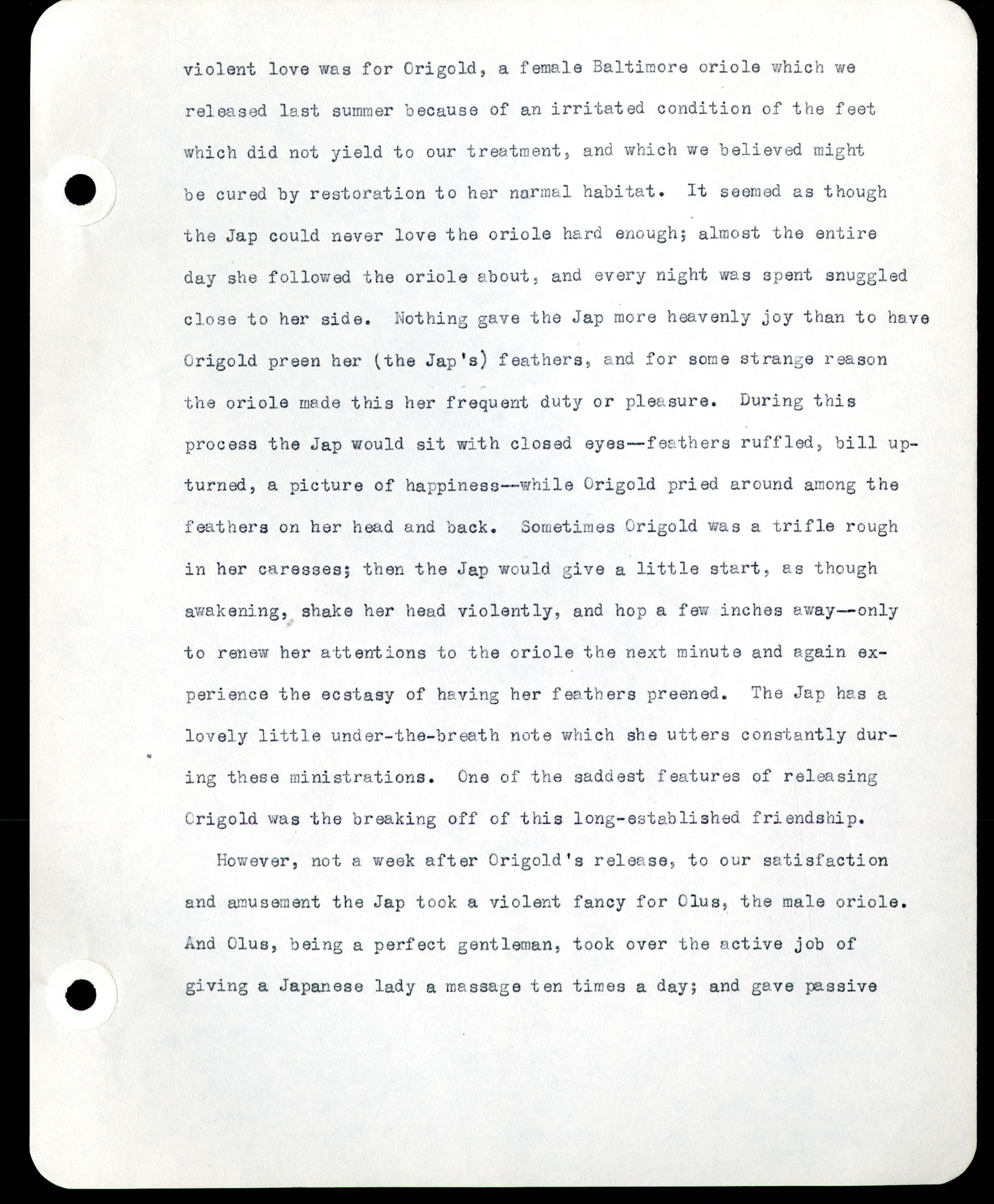 violent love was for Origold, a female Baltimore oriole which we released last summer because of an irritated condition of the feet which did not yield to our treatment, and which we believed might be cured by restoration to her normal habitat. It seemed as though the Jap could never love the oriole hard enough; almost the entire day she followed the oriole about, and every night was spent snuggled close to her side. Nothing gave the Jap more heavenly joy than to have Origold preen her (the Jap’s) feathers, and for some strange reason the oriole made this her frequent duty or pleasure. During this process the Jap would sit with closed eyes – feathers ruffled, bill upturned, a picture of happiness – while Origold pried around among the feathers on her head and back. Sometimes Origold was a trifle rough in her caresses; then the Jap would give a little start, as though awakening, shake her head violently, and hop a few inches away, only to renew her attentions to the oriole the next minute and again experience the ecstasy of having her feathers preened. The Jap has a lovely little under-the-breath note which she utters constantly during these ministrations. One of the saddest features of releasing Origold was the breaking off of this long-established friendship.
violent love was for Origold, a female Baltimore oriole which we released last summer because of an irritated condition of the feet which did not yield to our treatment, and which we believed might be cured by restoration to her normal habitat. It seemed as though the Jap could never love the oriole hard enough; almost the entire day she followed the oriole about, and every night was spent snuggled close to her side. Nothing gave the Jap more heavenly joy than to have Origold preen her (the Jap’s) feathers, and for some strange reason the oriole made this her frequent duty or pleasure. During this process the Jap would sit with closed eyes – feathers ruffled, bill upturned, a picture of happiness – while Origold pried around among the feathers on her head and back. Sometimes Origold was a trifle rough in her caresses; then the Jap would give a little start, as though awakening, shake her head violently, and hop a few inches away, only to renew her attentions to the oriole the next minute and again experience the ecstasy of having her feathers preened. The Jap has a lovely little under-the-breath note which she utters constantly during these ministrations. One of the saddest features of releasing Origold was the breaking off of this long-established friendship.
However, not a week after Origold’s release, to our satisfaction and amusement the Jap took a violent fancy for Olus, the male oriole. And Olus, being a perfect gentleman, took over the active job of giving a Japanese lady a massage ten times a day; and gave passive
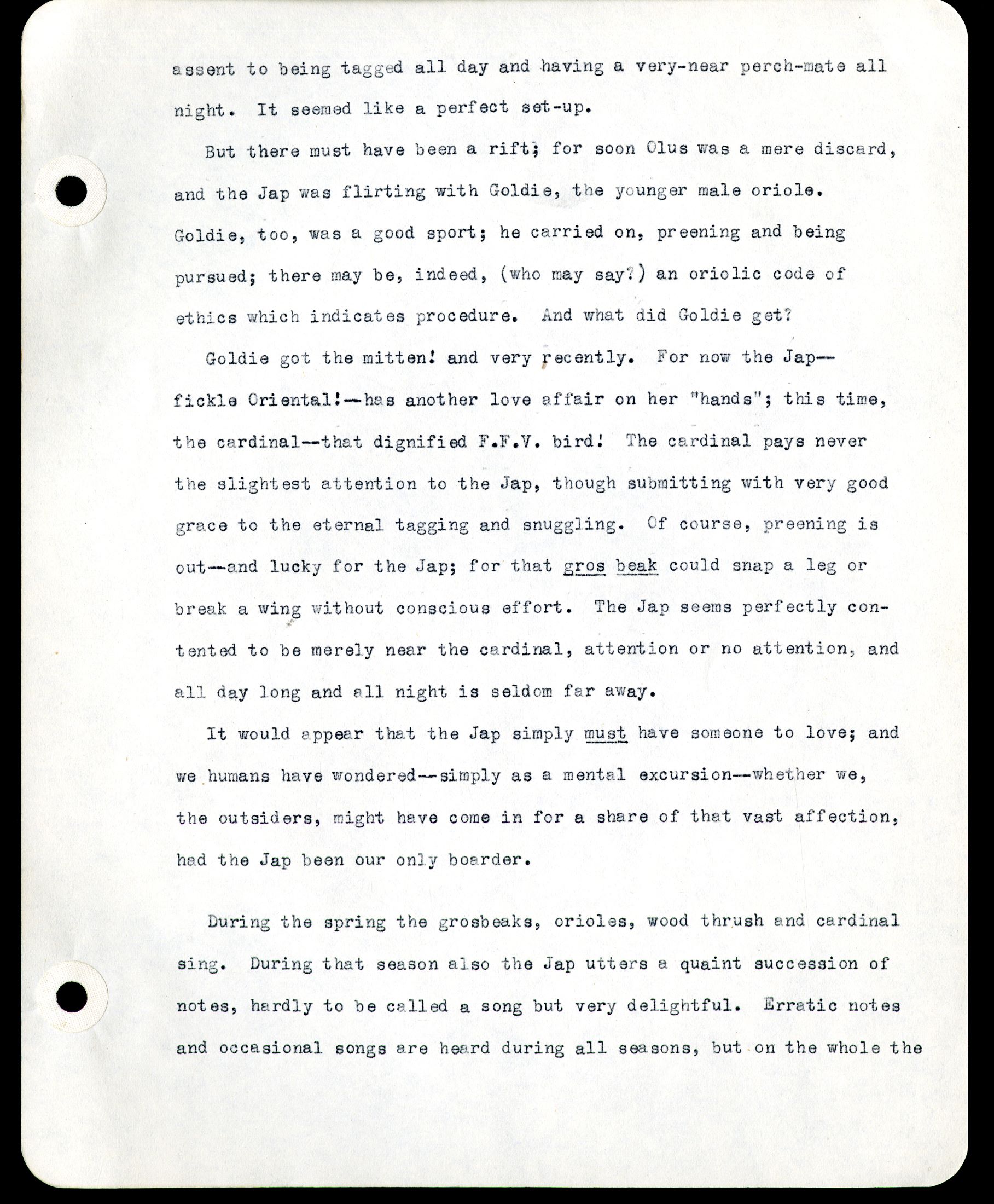 assent to being tagged all day and having a very-near perch-mate all night. IT seemed like a perfect set-up.
assent to being tagged all day and having a very-near perch-mate all night. IT seemed like a perfect set-up.
But there must have been a rift; for soon Olus was a mere discard, and the Jap was flirting with Goldie, the younger male oriole. Goldie, too, was a good sport; he carried on, preening and being pursued; there may be, indeed, (who may say?) an oriolic code of ethics which indicates procedure. And what did Goldie get?
Goldie got the mitten! And very recently. For now the Jap – fickle Oriental! – has another love affair on her “hands”; this time, the cardinal – that dignified F.F.V. bird! The cardinal pays never the slightest attention to the Jap, though submitting with very good grace to the eternal tagging and snuggling. Of course, preening is out – and lucky for the Jap; for that gros beak could snap a leg or break a wing without conscious effort. The Jap seems perfectly contented to be merely near the cardinal, attention or no attention, and all day long and all night is seldom far away.
It would appear that the jap simply must have someone to love; and we humans have wondered – simply as a mental excursion – whether we, the outsiders, might have come in for a share of that vast affection, had the Jap been our only boarder.
During the spring the grosbeaks, oriole, wood thrush and cardinal sing. During that season also the Jap utters a quaint succession of notes, hardly to be called a song but very delightful. Erratic notes and occasional songs are heard during all seasons, but on the whole the
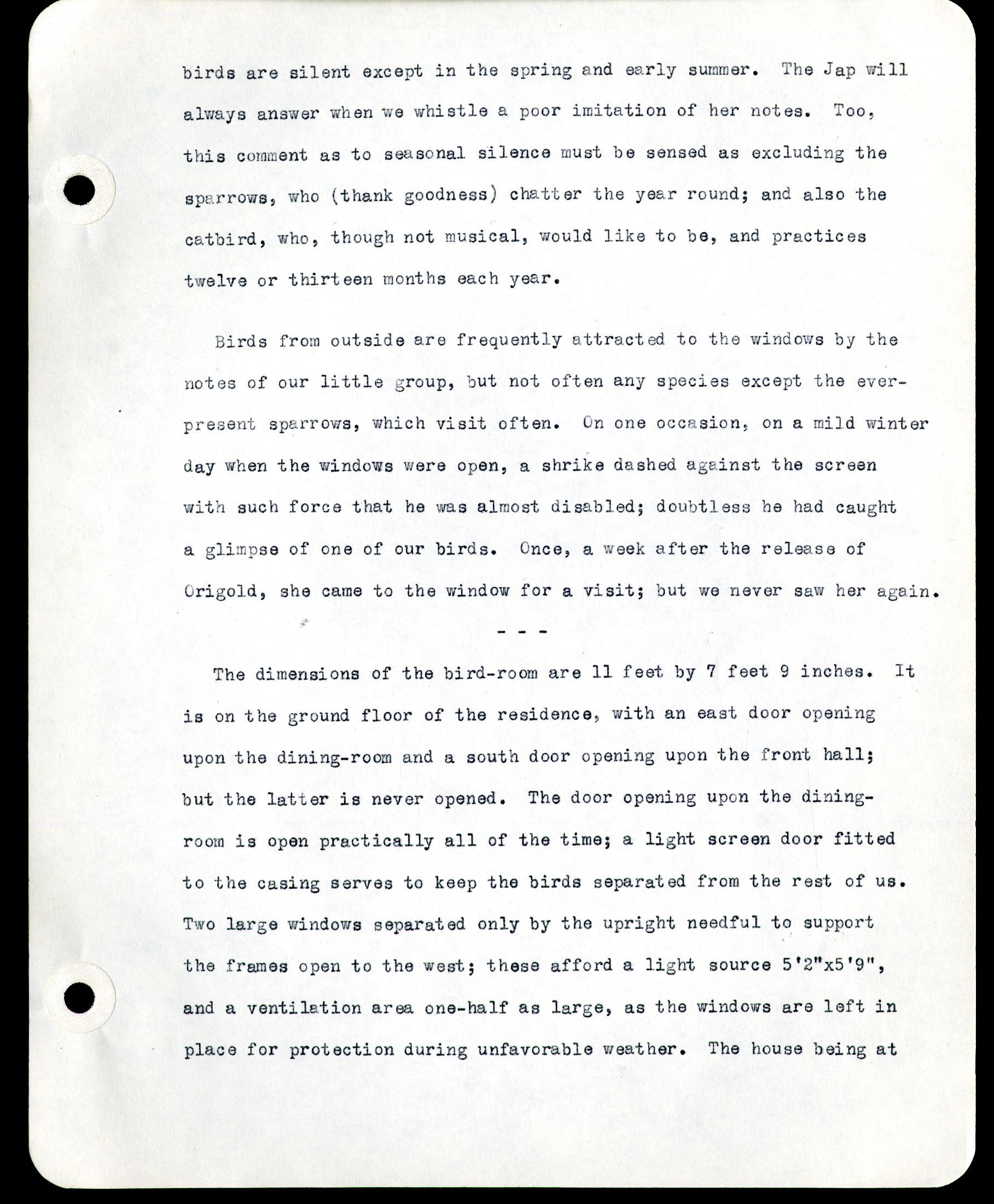 birds are silent except in the spring and early summer. The Jap will always answer when we whistle a poor imitation of her notes. Too, this comment as to seasonal silence must be sensed as excluding the sparrows, who (thank goodness) chatter the year round; and also the catbird, who, though not musical, would like to be, and practices twelve or thirteen months each year.
birds are silent except in the spring and early summer. The Jap will always answer when we whistle a poor imitation of her notes. Too, this comment as to seasonal silence must be sensed as excluding the sparrows, who (thank goodness) chatter the year round; and also the catbird, who, though not musical, would like to be, and practices twelve or thirteen months each year.
Birds from outside are frequently attracted to the windows by the notes of our little group, but not often and species except the ever-present sparrows, which visit often. On one occasion, on a mild winter day when the windows were open, a shrike dashed against the screen with such force that he was almost disabled; doubtless he had caught a glimpse of one of our birds. Once, a week after the release of Origold, she came to the window for a visit; but we never saw her again.
—
The dimensions of the bird-room are 11 feet by 7 feet 9 inches. It is on the ground floor of the residence, with an east door opening upon the dining-room and a south door opening upon the front hall; but the latter is never opened. The door opening upon the dining-room is open practically all of time; a light screen door fitted to the casing serves to keep the birds separated from the rest of us. Two large windows separated only by the upright needful to support the frames open to the west; these afford a light source 5’2”x5’9”, and a ventilation area one-half as large, as the windows are left in place for protection during unfavorable weather. The house being at
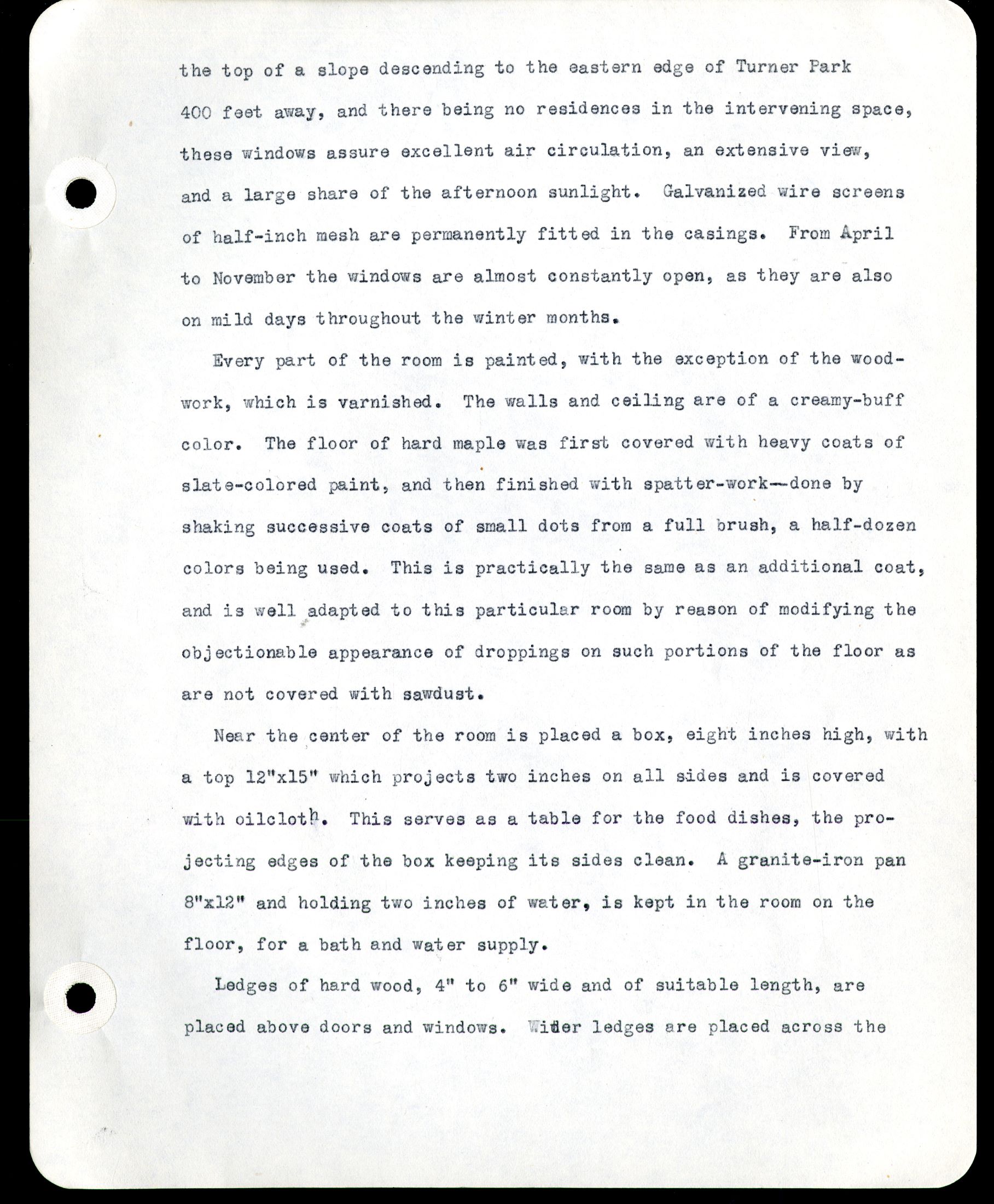 the top of a slope descending to the eastern edge of Turner Park 400 feet away, and there being no residences in the intervening space, these windows assume excellent air circulation, an extreme view, and a large share of the afternoon sunlight. Galvanized wire screens of half-inch mesh are permanently fitted in the casings. From April to November the windows are almost constantly open, as they are also on mild days throughout the winter months.
the top of a slope descending to the eastern edge of Turner Park 400 feet away, and there being no residences in the intervening space, these windows assume excellent air circulation, an extreme view, and a large share of the afternoon sunlight. Galvanized wire screens of half-inch mesh are permanently fitted in the casings. From April to November the windows are almost constantly open, as they are also on mild days throughout the winter months.
Every part of the room is painted, with the exception of the wood-work, which is varnished. The walls and ceiling are of a creamy-buff color. The floor of hard maple was first covered with heavy coats of slate-colored paint, and then finished with spatter-work – done by shaking successive coats of small dots from a full brush, a half-dozen colors being used. This is practically the same as an additional coat, and is well adapted to this particular room by reason of modifying the objectionable appearance of droppings on such portions of the floor as are not covered with sawdust.
Near the center of the room is placed a box, eight inches high, with a top 12”x15” which projects two inches on all sides and is covered with oilcloth. This serves as a table for the food dishes, the projecting edges of the box keeping its sides clean. A granite-iron pan 8”x12” and holding two inches of water, is kept in the room on the floor, for a bath and water supply.
Ledges of hard wood, 4” to 6” wide and of suitable length, are placed above doors and windows. Wider ledges are placed across the
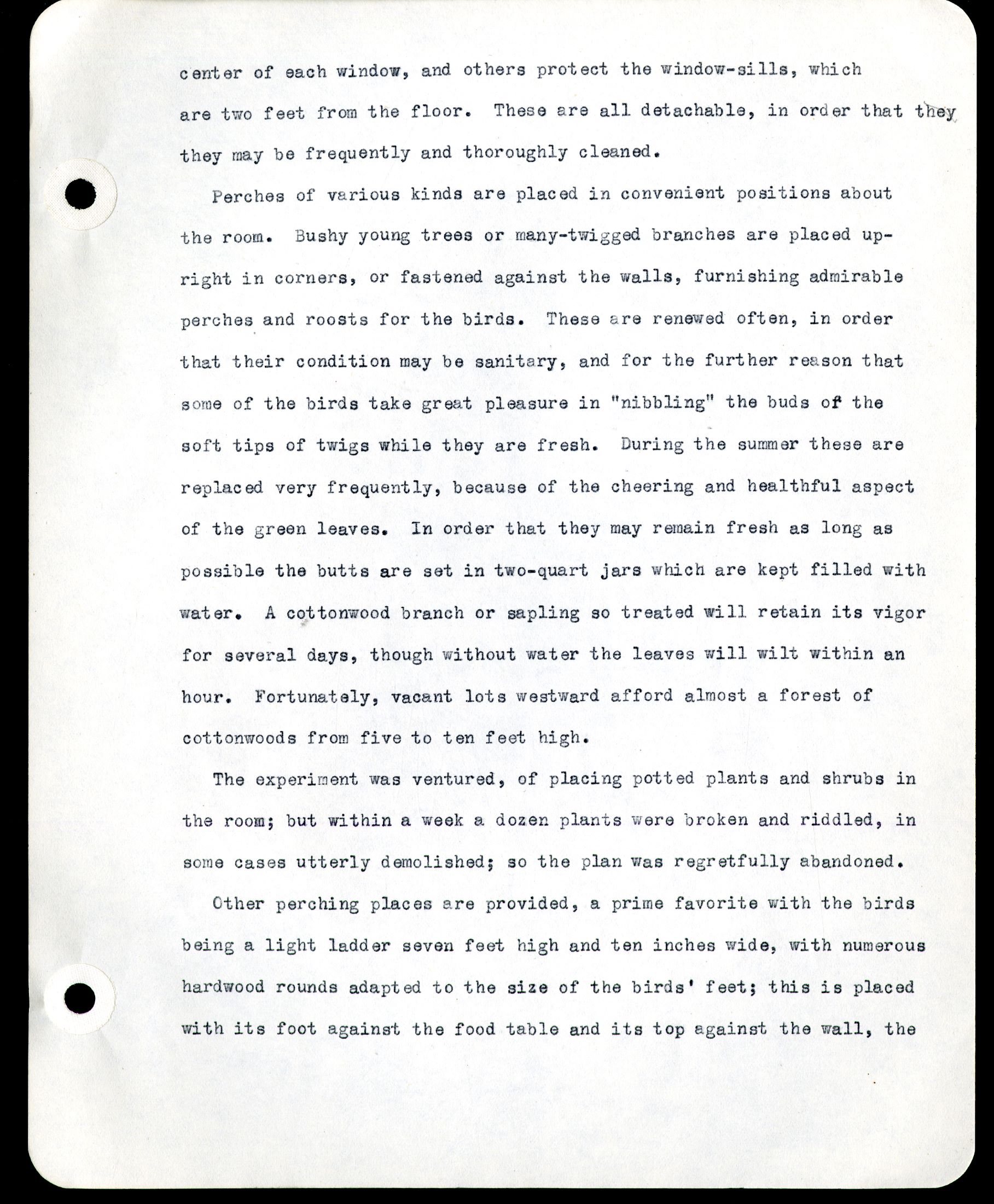 center of each window, and others protect the window-sills, which are two feet from the floor. These are all detachable, in order that they may be frequently and thoroughly cleaned.
center of each window, and others protect the window-sills, which are two feet from the floor. These are all detachable, in order that they may be frequently and thoroughly cleaned.
Perches of various kinds are placed in convenient positions about the room. Bushy young trees or many-twigged branches are placed upright in corners, or fastened against the walls, furnishing admirable perches and roosts for the birds. These are renewed often, in order that their condition may be sanitary, and for the further reason that some of the birds take great pleasure in “nibbling” the buds of the soft tips of twigs while they are fresh. During the summer these are replaced very frequently, because of the cheering and healthful aspect of the green leaves. In order that they may remain fresh as long as possible the butts are set in two-quart jars which are kept filled with water. A cottonwood branch or sapling so treated with retain its vigor for several days, though without water the leaves will wilt within an hour. Fortunately, vacant lots westward afford almost a forest of cottonwoods from five to ten feet high.
The experiment was ventured, of placing potted plants and shrubs in the room; but within a week a dozen plants were broken and riddled, in some cases utterly demolished; so the plan was regretfully abandoned.
Other perching places are provided a prime favorite with the birds being a light ladder seven feet high and ten inches wide, with numerous hardwood rounds adapted to the size of the birds’ feet; this is placed with its foot against the food table and its top against the wall, the
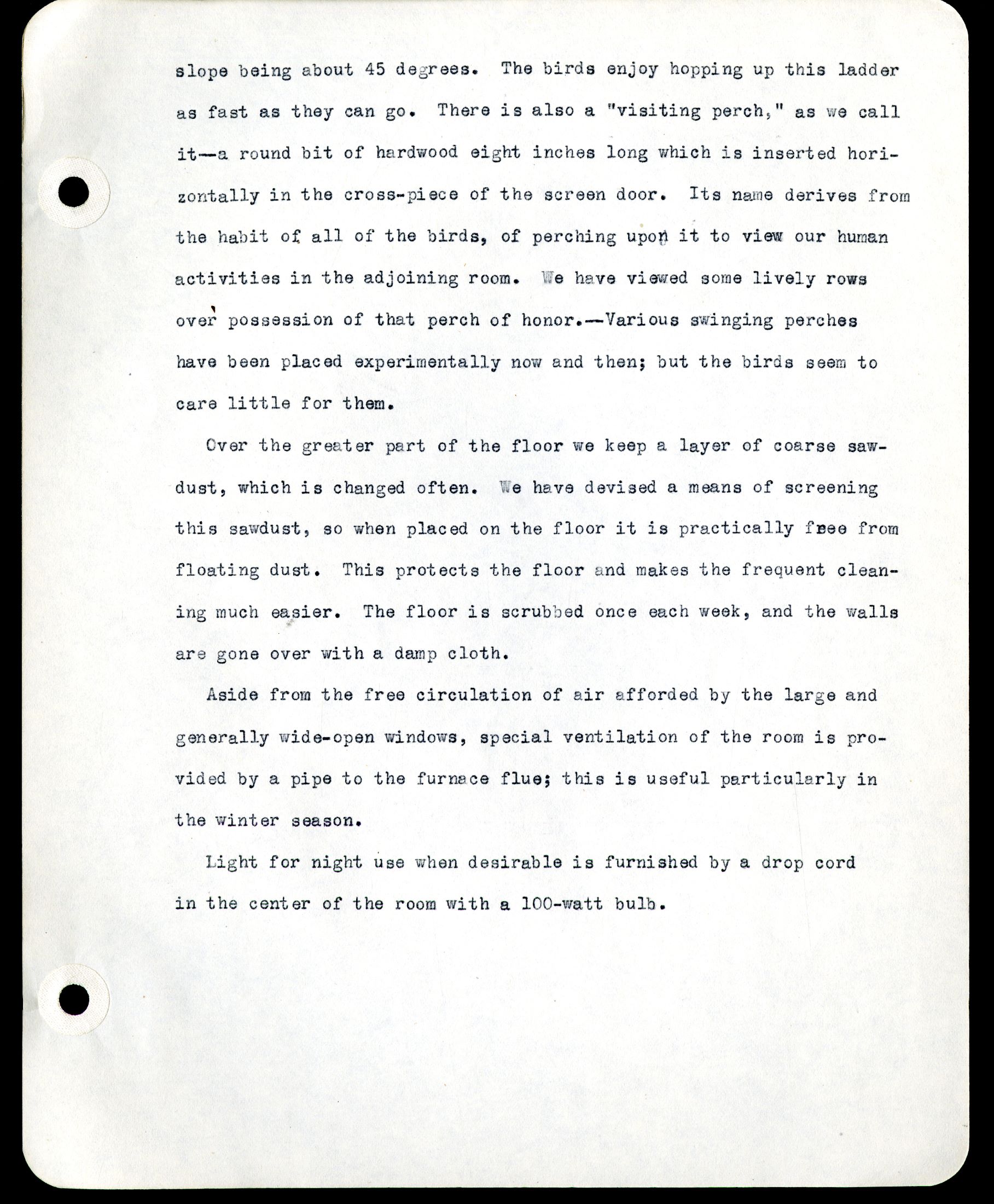 slope being about 45 degrees. The birds enjoy hopping up this ladder as fast as they can go. There is also a “visiting perch,” as we call it – a round bit of hardwood eight inches long which is inserted horizontally in the cross-piece of the screen door. Its name derives from the habit of all of the birds, of perching upon it to view our human activities in the adjoining room. We have viewed some lively rows over possession of that perch of honor. – Various swinging perches have been placed experimentally now and then; but the birds seem to care little for them.
slope being about 45 degrees. The birds enjoy hopping up this ladder as fast as they can go. There is also a “visiting perch,” as we call it – a round bit of hardwood eight inches long which is inserted horizontally in the cross-piece of the screen door. Its name derives from the habit of all of the birds, of perching upon it to view our human activities in the adjoining room. We have viewed some lively rows over possession of that perch of honor. – Various swinging perches have been placed experimentally now and then; but the birds seem to care little for them.
Over the greater part of the floor we keep a layer of coarse sawdust, which is changed often. We have devised a means of screening this sawdust, so when placed on the floor it is practically free from floating dust. This protects the floor and makes the frequent cleaning much easier. The floor is scrubbed once each week, and the walls are gone over with a damp cloth.
Aside from the free circulation of air afforded by the large and generally wide-open windows, special ventilation of the room is provided by a pipe to the furnace flue; this is useful particularly in the winter season.
Light for night use when desirable is furnished by a drop cord in the center of the room with a 100-watt bulb.
 Extracted from article on “Canaries and Other Cage-bird Friends,” Alexander Wetmore, Nat. Geog.Mag. Dec. 1938
Extracted from article on “Canaries and Other Cage-bird Friends,” Alexander Wetmore, Nat. Geog.Mag. Dec. 1938
Red-billed Hill Tit
The slightly little “Japanese robin” (Leiothrix) lute) is wrongly named, since it is found from southern China to northern India and Burma and does not occur wild in Japan. It is better called the “red-billed hill tit.” It requires soft food, but is hardy and easily handled in cage or in aviary, and pays for its care in its alert, active movements and pleasant warbling songs.
